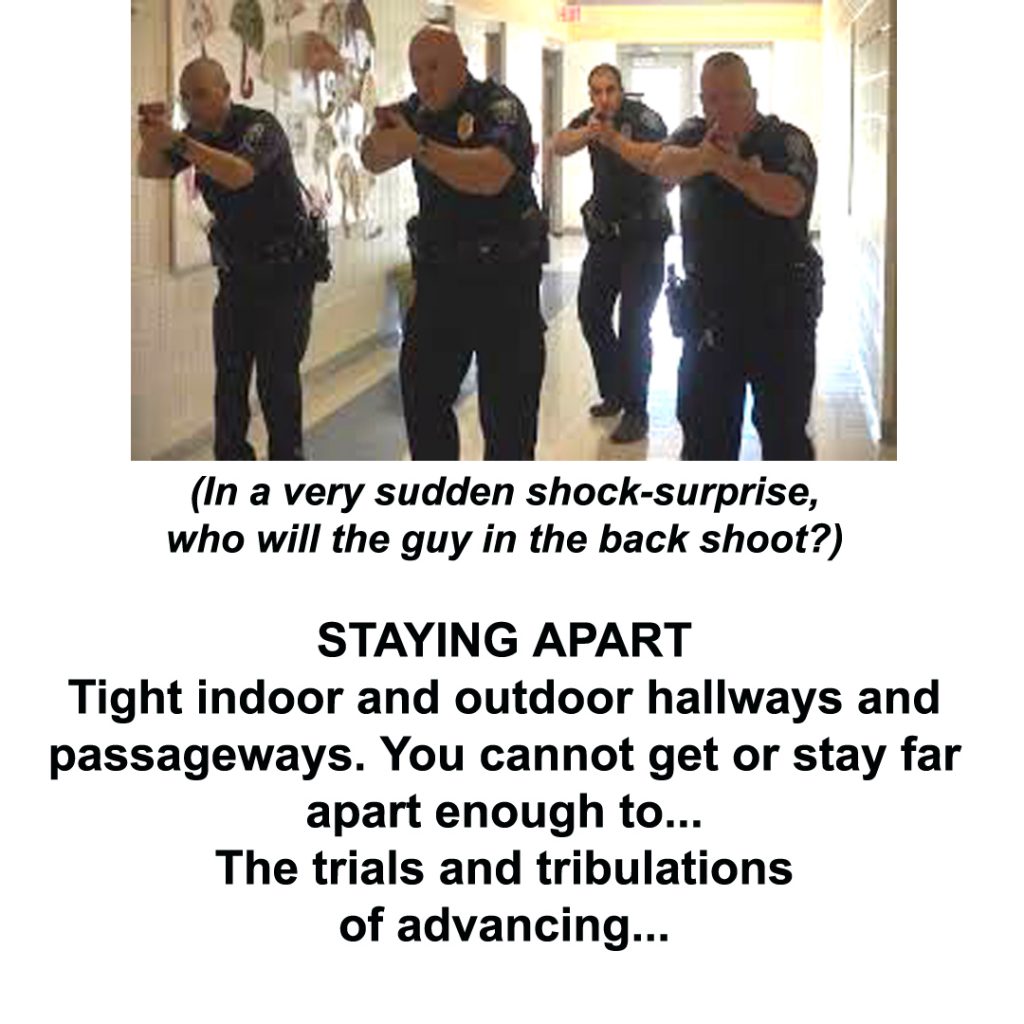
- “Okay, now…where will SWAT park?”
- “Where will the response team stage?”
- “Where will the Bradley stage?”
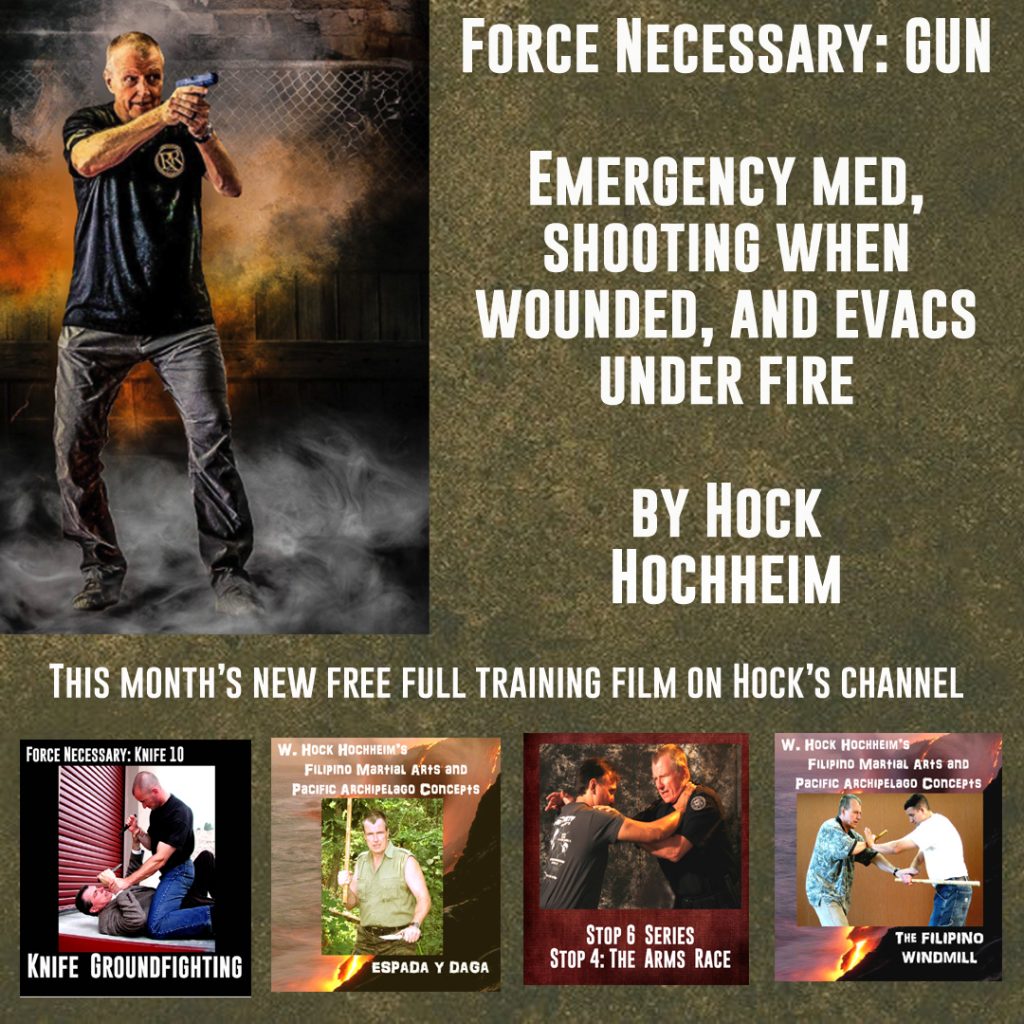


I stumbled upon yet another character on the web that criticizes knife instructors (in general) and their various titles. I was not mentioned and someone else was the real, make-fun-of target. How dare we teach knife tactics and not be Jim Bowie? How dare you call yourself a knife “expert,” is the theme.
Lots of titles in topics, basic, advanced, expert, subject matter expert, master (lots of pros use that acronym “SME”– I do) etc. The complainers like to ask, “how many of these guys have ever been in a knife fight?” Many of these complainers also like to say that knife trainers are not needed. “Just stick the pointy end in. Ha-ha.” This ignores the myriad of laws, situations and skills. I am reminded of some of the 1960s and 1970s police ground fighting training we received that was summed up with,
“Tackle. Punch. ‘Swim’ to a choke. Handcuff the unconscious suspect.” Oh, it’s just THAT easy? Then why all the time and grade training. That’s like the “just stick the pointy end in” easy?
Anyway, frequently these “pointy-end-in” complainers are so often dedicated gun guys, who should then be content with just “sticking the pointy end of a bullet in.” Right? But instead, they spend fortunes on never-ending, redundant before-during-and-after shooting courses from…instructors who have never been in any gunfights either. Famous yes? Maybe? Close – but no real-world, cigar. Then they get certified from non-gunfight teachers. People think of the title master as a martial arts rank only but there are gun programs that create gun masters, gun experts and even gun grandmasters.
Which is my point (pun intended). Declaring that all knife instructors must have been in numerous knife fights to teach, is like asking the same of gun instructors. Same-same, yet the U.S. is chock full of very busy shooting instructors who have never been in gun fights. Chock, chock full. What about all these combatives and “Kuraty” black belts and instructors who have never been in so-called “real” fights (not talking about ubiquitous, average tournaments here. If you want to be a sports champion, there are many experienced sport champs around to learn from). But, the “must have been in” rule is either a broad rule for all, or not much a rule.
In the big picture, not many people have “been in” anything they teach. For example, we know that many business expert, college professors and economists have never run a single business. There are many trained expert astronauts that have never been in outer space. There are many trained Chinese history experts who’ve never step foot in China. Should I go on and on with this never-ending list? You know what I mean.
So, what about the “Next Best Thing” rule? Most of the world has never “been in” a hand, stick, knife and gun fight. Most of these other topic instructors never have either. And folks do like to learn from those that have been “in.” But such sources and contacts are hard to find and expensive. So instead, most of the world meet downliners and this is where we get the titles “first generation, second generation” instructor nomenclature and why such designations might actually be important. And folks learn from researching the field. After a period of time of one or both study sources, these thirsty downline folks can become smart, subject matter experts. Oops, there’s that “expert” word again.
I myself have spent a lot of time and money traveling far and wide to train with really experienced people. I see and feel the experience. The advantage. The military and policing life have offered up these connections to me. But I would NEVER automatically belittle anyone who has never “not-been-there, not-done-that.” Some of the smartest people I know have never “been-there, done-that,” yet have the intelligence IQ and emotional IQ to excell, and are even smarter than the original, real-world experienced pros. Oh, yes. It’s like a genetic crapshoot, a macabre dance with nature-nurture and chance. That whole topic is called, “picking the right instructor!” (Find someone smarter than you.)
So why just pick on knife teachers? As I suggested I often waste my time by looking these knife complainers up. This particular aforementioned chap, works in a bread company, a bakery-factory. Oh sure, he has the prerequisite long beard and covered in tattoos for sure, but he makes bread. And…yes, he is a gun instructor. According to his resume, he’s never been a cop or in the military and I would bet, odds are then, never been a gunfight. Otherwise, he looks to be a great guy and a patriot and dedicated family man. Thumbs up, dude. And he might be, could be still be a fantastic gun instructor, even sans a gun fight – yet still an expert handler of the material. But he is exactly like that knife instructor, sans a knife fight, he throws stones at. The saying “people who live in glass houses shouldn’t throw stones” comes to haunt.
How important is “Have Been In?” How important is “Been-There, Done-That?” How important is the “Next Best Thing?” Well, source-important is vital, yes, but the sources are a tiny minority in all fields and they’re hard to find and usually expensive. You learn from the best you can find and the majority of the time, it’s from those first, second, third or more generation sources. Let’s not be ignorant complainers and loudmouths living in glass houses about these first, second or thirders. They might be smarter than you. You “learn up the ladder.” Life, learning and skill is lot more than just sticking the pointy end in. Learn up.
______________________
Coming soon from Piccadilly Publishing in Great Britain…
Force Necessary: Hand Level 6 Strike: The Elbow Strike
Yes, the popular elbow strike is number 6 in the strike list. Not that it is 6th in importance, it’s just that everything cannot be number 1, and things need to be stretched out for digestion. Remember our mission is not to create champion kick or Thai boxers, but develop self defense, survival skills.
The elbows are very close quarters strikes. Sport applications can easily be confused with survival applications by naive instructors within the spinning worlds of self defense and sport. I have heard various self defense system instructors regurgitate a lot of sport doctrine. Survivorialist borrow (some like to say “steal”) from sports and shouldn’t automatically, completely replicate them. So what’s different?
Cutting AND Smashing? Take for example the generic instruction that the elbow is used for both cutting and smashing. Suffice to say that the best smashing impact deliveries are the striking surfaces just a 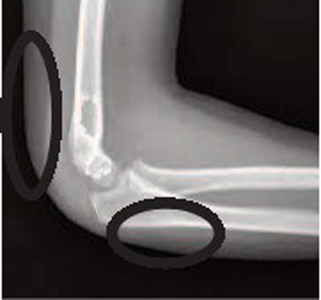
The Striking Version. Many experts suggest incorporating your big bones as much as possible. You might say, “elbow-area” striking for self defense and elbow tip striking possibilities for sports cutting. It’s more than semantics.
The Cutting Version. Hitting with the very tip of the elbow may cause 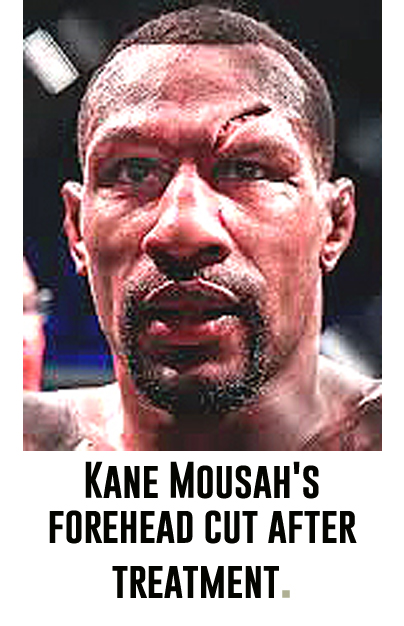
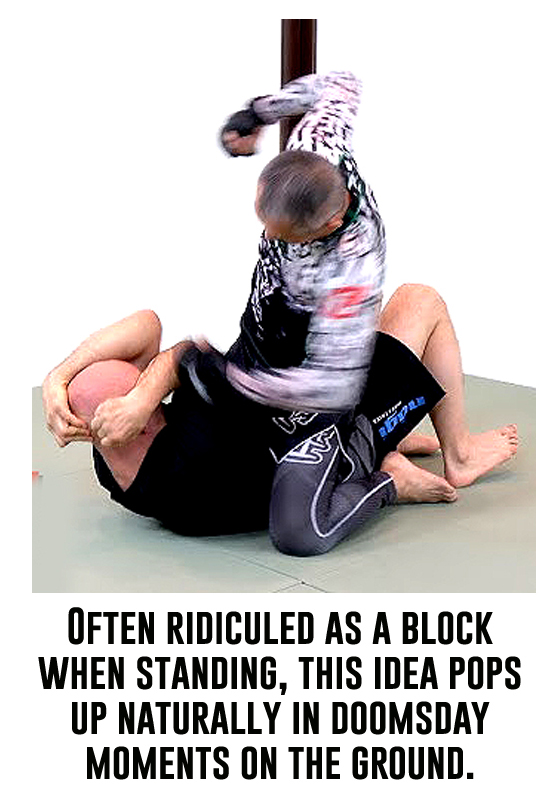
Better to Give than Receive. When in elbow delivery range, you are in elbow reception range, a common Thai Boxing theme. Where does your support hand and arm go? Inexperienced practitioners, especially 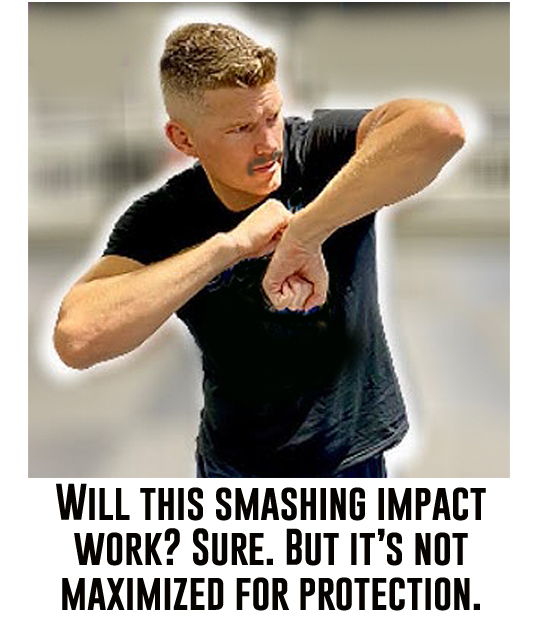
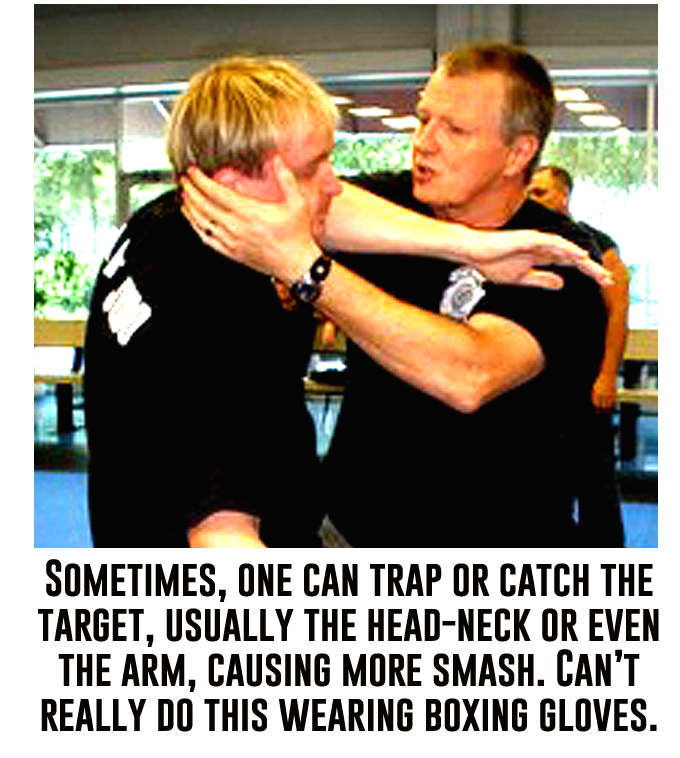
Note: Thai boxers often deliver horizontal and near horizontal incoming elbow strikes with that arm’s wrist bent and hand pointing down. This allows for the deeper range and penetration of the strike, whereas the straight wrist and hand inhibits that deeper strike because your hand hits your torso. In big gloved Thai fights, this hand position is hard to observe. The bent wrist might not matter much. This is just what I was taught in the Master Chai Sirisute Thai Boxing system. We report. You decide.
The Basic Elbow Smash List: The old saying is, “if you have a good hook (punch) you have a good elbow (and vice-versa), as the body dynamics are somewhat similar. The combinations seem endless and class time should be spent working on them. Do these standing, kneeling and on the ground (as in top, bottom, right side, left side), all where feasible.
Horizontal or mostly horizontal elbows.
– right traveling left.
– left traveling right.
Vertical or mostly vertical elbows.
– mostly downward direction, including diagnials.
– mostly upward direction, including diagnials.
Thrusting elbow.
– to the front, sides and back.
Spinning elbow.
– mostly horizontal.
– 1/4 or 1/2 or 360 spins. Requires some foot and torso set up that at times can be similar to spinning kicks.
– should you feel uncomfortable spinning, you still need to see them used on you and defend against it.
This Level 6 Elbow Module includes all this and elbow scenarios, tricks and skill drills, all too much to to list here. Level 6 also includes the Level 6 kick – the Thrust Kick Module, the Level 6 Emergency Medical Module, and the 6th Stop of the Stop 6 Program which is the survival ground fighting module. Ask for the new and improved Force Necessary: Level 6 Requirements Outline. It’s free and available after 15 February, 2024.
See all the free full training films on Hock’s Combatives TV Channel, click here.
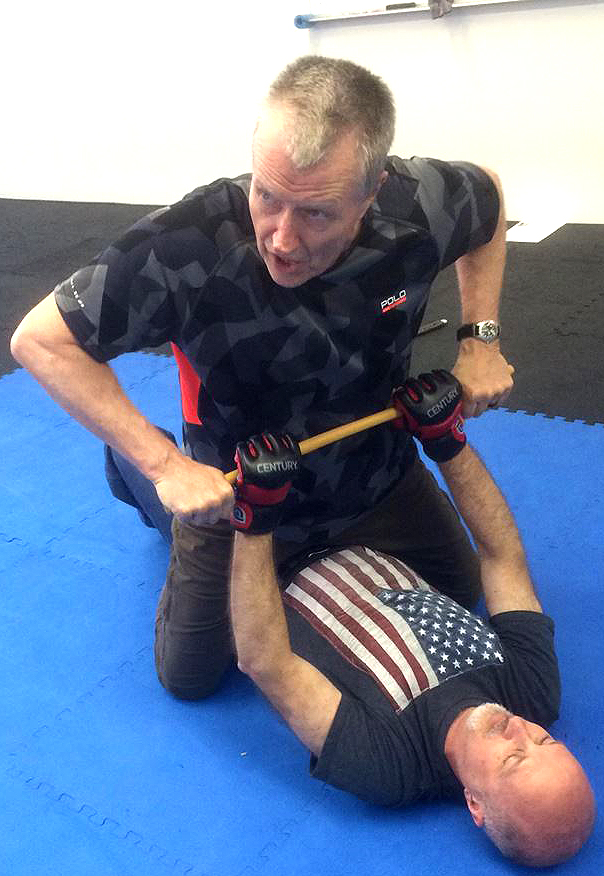
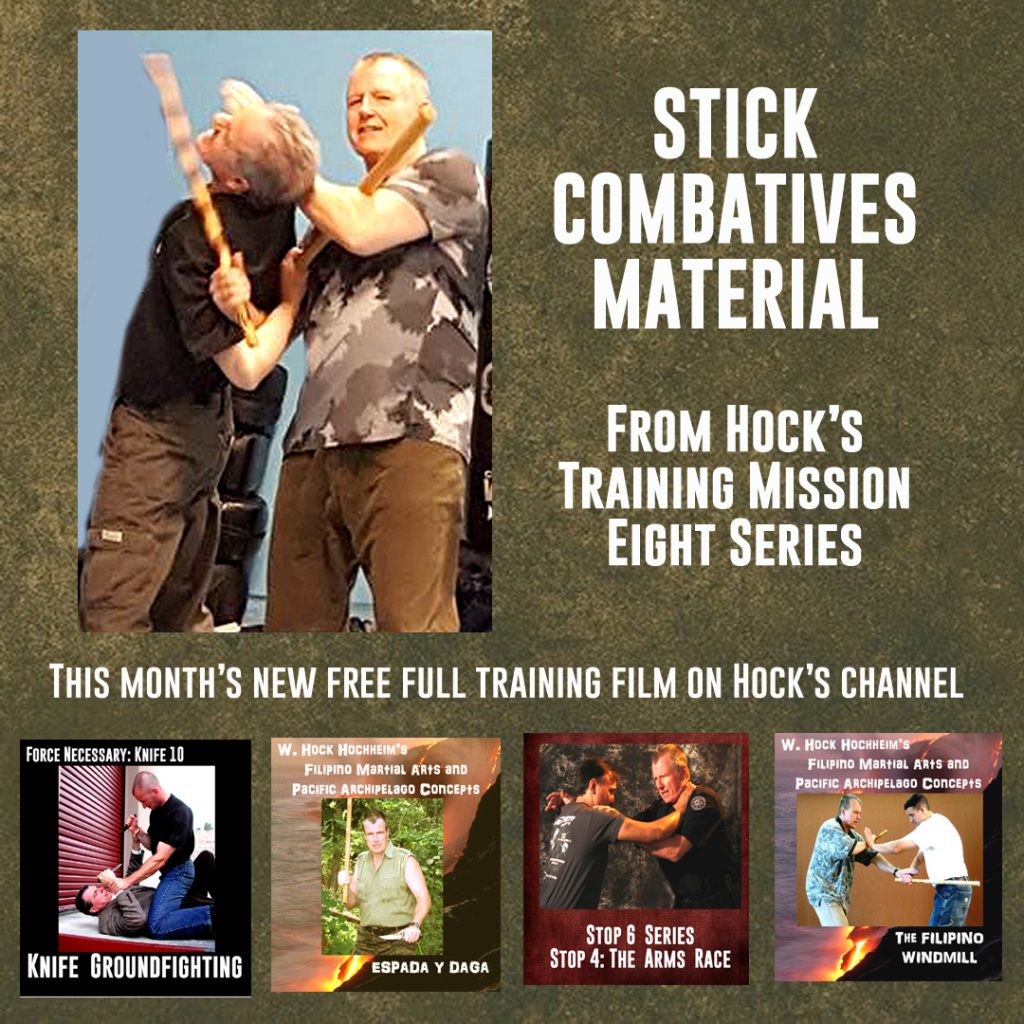
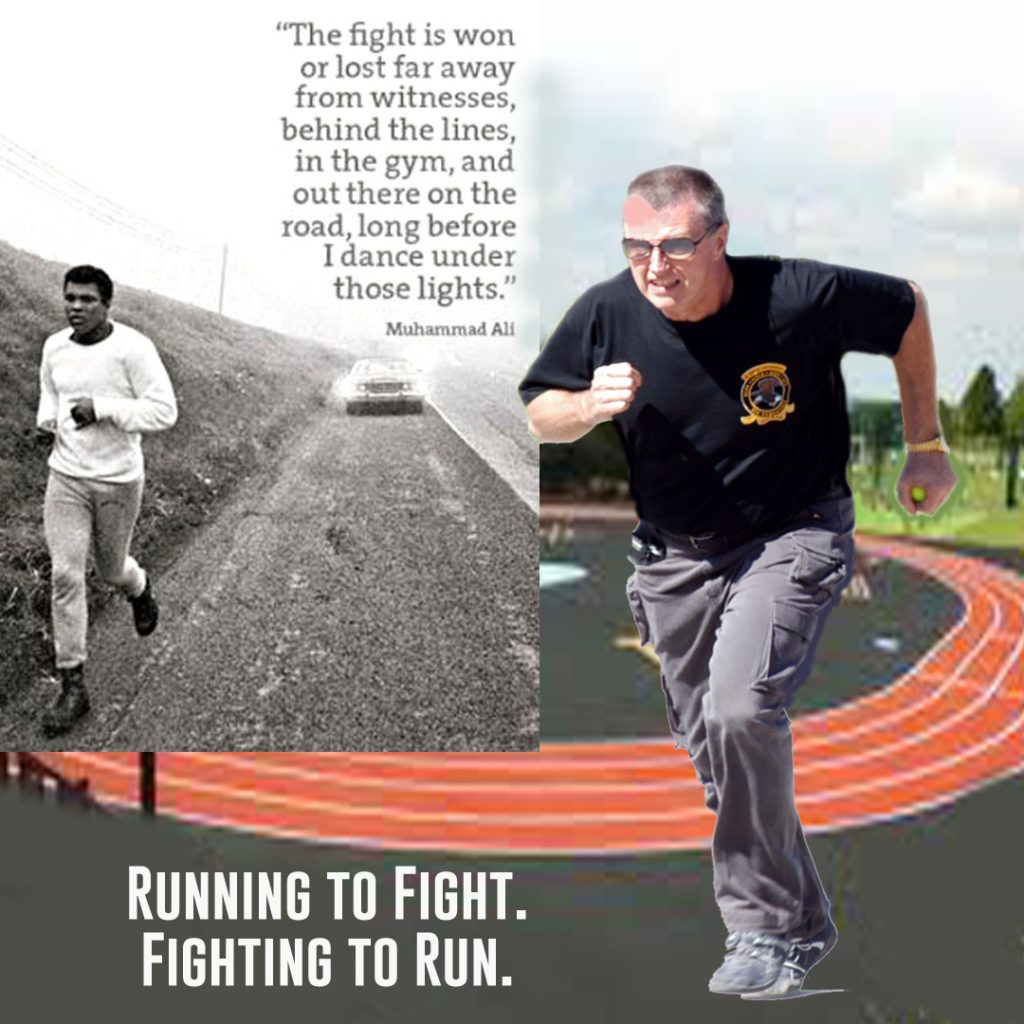
 I find this more multi-lap-to-a-mile handy because I change “themes” on each lap and easily remember to do so. I don’t think I have the time and the mojo to do my whole workout listed below, changing themes every classic quarter mile on the big boy track. If you did one of these chores as one full lap, and four laps make for a mile…it would be a long (and exhausting) many-mile day.
I find this more multi-lap-to-a-mile handy because I change “themes” on each lap and easily remember to do so. I don’t think I have the time and the mojo to do my whole workout listed below, changing themes every classic quarter mile on the big boy track. If you did one of these chores as one full lap, and four laps make for a mile…it would be a long (and exhausting) many-mile day.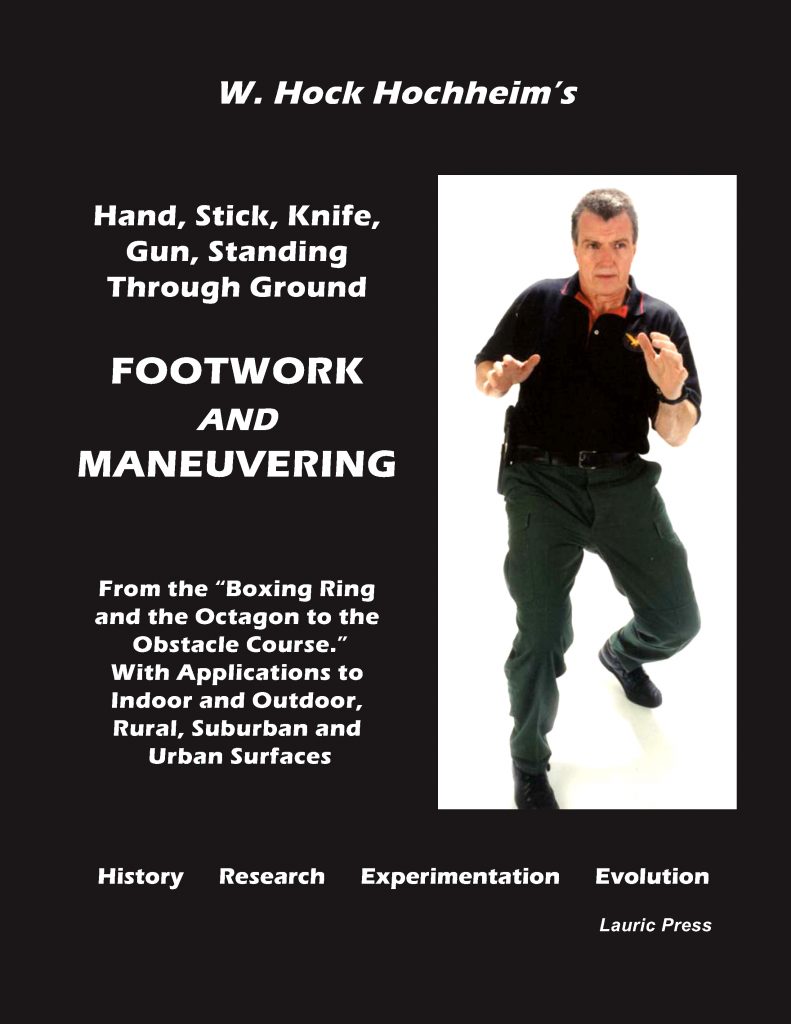

I have been in court a lot, military, state and federal, helping prosecutors win cases I brought forth, for three decades. I even worked for defense attorneys in the subsequent years as a private investigator. This process was an incredible legal education. I came to believe that the best patrol officers are former detectives. The best detectives are former prosecutors. The best prosecutors are former judges (especially appellate). Of course, this reverse engineering ladder of sorts, this learning curve is impossible to officially implement.
But, I feel lucky to at least have worked in these worlds. Back then, District Attorney Jerry Cobb and his top assistants were better than most investigation schools on what details gets convictions. (Two such great and dedicated staff minds were Alan Levy and Lee Gabriel.)
(Me atop the Denton County, Texas Court House, circa 1980s. In the distance is the original courthouse on the classic downtown square. )
The law makes you think about all things big and small. The who, what, where, when, how and why. A police officer asks those questions for the crime report. The detective digs deeper. In the grand jury and trial stage we must dig even deep – deeper because you never what what tiny problem might arise in court.
Law school should export critical thinkers. All lawyers should be critical thinkers. They are often not. But they should be. I know lawyers who are doffusses and some think like criminals.
Juries and Jurors: And Lord knows common jurors… your wonderful peers… have no training in critical thinking. It’s the pot luck, roulette wheel of your freedom and fortune.
When I was an investigator in the US Army and in those court martials, the juries consisted of officers, usually college grads. No guarantee of critical thinking, but on paper at least they appear probably smarter than civilian “Joe-Shit-The-Rag-Man,” juror, often was-is someone who was never taught civics in school, the law or government or unbiased history. Often was-is someone that when questioned think Abe Lincoln was the first president. Often someone who failed to avoid jury duty and sometimes even fall asleep in the jury box. (Oh yes, I could tell you stories – well, I have, in my book below, actually. Judges are supposed to “wake up” jurors. Naps never happens in military tribunals. Oh no. And in federal court the judges are VERY powerful and sleepers are awakened by “thunderbolts” from the bench. But in state and county courts, not always. To counter the snoozers, I would sometimes fake a loud sneeze into the microphone when testifying and coming to a vital speech point. I would watch the nappers’ heads bolt up. I would wait a few seconds for them to come to their senses. Everyone in the court knew what I was doing, but it was a Oscar-level, sneeze performance with which I could contest any objections.)
One of the many things I learned that for the colonel, the scientist or the carpet-layer to totally draw conclusions, they need to hear and analyze total evidence. Thus…the “Total Evidence theory.”
“There’s a crucial principle in probabilistic reasoning known as the ‘total evidence requirement’. This is roughly the principle that we should always use the most specific evidence available to us. Suppose the prosecution tells the jury that the accused always carries a knife around with him, neglecting to add that the knife in question is a butter knife. The prosecution has not lied to the jury, but it has misled them by giving them generic information – that the accused carries a knife – when it could have given them more specific information – that the accused carries a butter knife. In other words, the prosecution has violated the total evidence requirement.” – Phillip Goff is professor in philosophy at Durham University, UK. Writing in Aeon Magazine
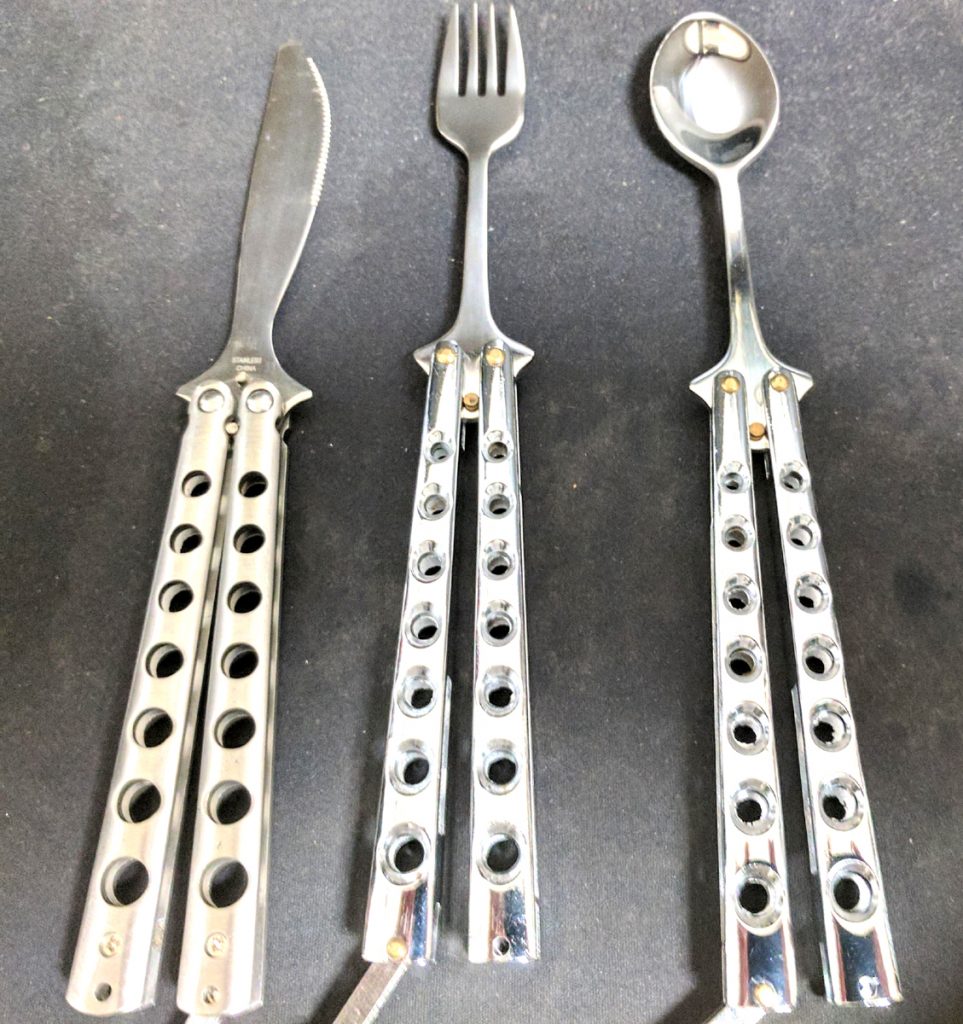
(My book covers much police action and many issues like this. The title was invented by the publisher and not my choice. When you sell a book, titular things like this are out of your control. Ebook or paperback. Click here. )
Kajukenbo Okayama: Hoch, tell us about yourself.
Hock Hochheim: Well, that’s sort of the “Who, when, what, where, why” that I use everywhere. And I do ask that question…“Who?” “Who are you, really?” And in our business, who do you really expect to fight? There’s a psychology where older people think less of themselves, and then younger people think more of themselves, in terms of what they think they can do, and who they can fight and win against. This is so true that there are actual psychological terms for both of those categories, but they escape me now. I have to continually look them up every couple of years to remind myself.
But I’m just a former army, military, police investigator. Then Texas police, and in most of that time, in those 23 years, a detective, about 16 or 17 years of that. And since 1972, starting out at Ed Parker Kenpo-Karate, I’ve been a martial artist, other than a few rare years maybe, while in the army. I’ve just done this every day for…I think the number now is pretty much 50 years, 51 years… Fifty years, fifty-one years of thinking about/worrying about/being psychologically obsessed with these elements of fighting. To a fault, I think. I think it’s a bit of a mental sickness.
KO: (Laughing)
HH: I should be thinking about other things. Which I do, yes. I think about writing my novels, but also my mind wanders back to organizing this martial material…what’s better, what we can cut out, what we absolutely need. And in the terms of hand, stick, knife, gun, war and crime, it’s quite a challenge. It’s still a daily challenge, after all these years.
KO: Tell us more about your martial arts history.
HH: I was in Kenpo-Karate, I guess about a year, and then I went to the army. So, I had this established impression of martial arts. In the army, there was just a couple opportunities to train. Boxing. Police Judo. First of all, I was in Korea, and I wasted my time there, martial arts speaking. I say I wasted my martial arts time there because…I hate to use the word “brainwashed”…but I was so immersed in the idealism of parker Kenpo, and how superior it was, as they told us, that I really did not want do anything else. Now, I should have done Hapkido at least while I was in Korea. I’m not really a big fan of Tae Kwon Do, I like their power kicks, but gosh, I could have done Hapkido! We had opportunities. There were a couple ROK Marines there teaching military combatives classes at another base gym, So I did that.
The military police academy was kind of big on boxing as a support system, which also had its inherent problems. But since I was in Karate, as soon as I got there, I did their boxing stuff. And it’s very hard to take sports boxing with gloves and transform it into bareknuckle fighting and reality arrests. There’re real problems with trying to make those two come together.
And so, anyway, then I got out of the Army, I did Karate and Jiu-jitsu back in Texas…the stand-up, old school Jiu-jitsu. And then, in 1986, I started in with the Jeet Kune Do people. And that was just a big mind explosion. I was very happy to get out of the classical framework, as suggested by Bruce Lee.
So, we’re talking Dan Inosanto and his top instructors. Thai boxing, the Filipino martial arts, Jeet Kune Do, Wing Chun…all the things that they were doing was just a massive amount of cool investigative stuff. And that went on, probably, I guess, until about 1997. Oh, and then of course I picked up with Ernesto and Remy Presas. And that was a huge chunk of time. I got very close to both brothers. They often stayed at my house, which was a fantastic opportunity for me.
I lived in middle of the country, and they needed to stay weekdays somewhere between their weekend seminars, and I was a bachelor, and they just flat out asked me: “Hock, can I stay, you know, Tuesday through Thursday?” Or, “Monday through Friday morning?”
Then about ’97 I really decided to get free of everything, and clear my head, and create exactly what I dreamed of. Y’know, all these decades, I was in the pursuit of the “perfect martial art,” so to speak. Survival fighting with hand, stick, knife and gun in crime and war, standing through the ground. And after I’d done all of these things, I realized there was none. No one perfect thing.
And so I decided to embark on this blend…I guess the best word is “combatives.” A word that wasn’t popular in the ’90s, but I picked that word anyway. It became popular later, to a shaky extent.
KO: Before you got into Jeet Kune Do, I hear you had a run in with Kajukenbo?
HH: Yeah. So, in Ed Parker Kenpo Karate, North Central Texas…which was one of the rarest of official martial arts schools you’re gonna find back in the late 1960s and early 70s. I found one and joined. We had two private lessons a week, and Saturdays was set aside for a group lesson. A couple of hours, and that was your typical group martial arts class in many ways. And at the end of the Saturday session, they had organized…Keith See was the guy, one of the first generation Parker guys…they had organized a sort of open, sparring class with as many other schools as you could find at the time. There was Tae Kwon Do, there was Kung Fu, there were various arts. And since part of Parker Kenpo was very kickboxing oriented, we usually sort of “won-beat” everything against these other people.
It just created a “wow” factor, like some of these folks were really dramatically moving into artsy, unsafe positions (as taught by their arts), and we’re just kickboxing at this point. Not good for them. We were always very friendly. There weren’t any kind of feud problems.
But then all of a sudden, who shows up one of these Saturdays in 1972, but the local, Kajukenbo guys. And all of a sudden, they were like us. They were a mixed kickboxing outfit. And so “Wow!” we said. And so no, we did not overcome them. And y’know, it was very much an equal experience. “These guys are like us! They’re from Hawaii, they’re doing the same things…” So that was my first introduction to Kajukenbo, and these guys. And, as time marches on, we’re all going to seminars, and we get to know each other and stuff. And then of course a long time ago, early 1990s I met Dean Goldade, he was a Professor Gaylord black belt. We worked consistently together for decades. I also got close with another Prof Gaylord guy, great guy, Ron Esteller. I have done dozens of seminars at his place over the years. I’ve done a seminar with Prof. Gaylord in California, so I know all these guys, and it’s just been a gigantic friendship ever since.
KO: What was it like in the martial arts world when you first started?
HH: Those guys were super tough. I joined…I started, in 1972, just after the blood and guts era of Karate training. It was sort of an assumption that this old martial arts training style could not be a successful business, if you have to vomit or bleed every Tuesday 
I saw the same thing happen to Thai boxing. In, oh I guess about, the late ’80s or early ’90s, where suddenly you were not beating the snot out of each other all the time in class. Before that there were just constant injuries, and business problems with that. And of course Bruce Lee had this same problem at his YMCA classes in Los Angeles, which is why he created that YMCA boxing program, which Tim Tackett taught me. There’s a lot of great, hardcore, application drills in that program. It meant that James Coburn didn’t have a black eye when he went to the movie set. And the doctors and the lawyers training with Bruce, y’know, weren’t all busted up.
So, he created this kind of program that was focus-mitt oriented…and you’ve seen bits and pieces of it in the Jeet Kune Do world through time. The little sets of things, strike/counter-strike, sets of three, sets of four…I still use those. But my mission is not to create a boxer or a kickboxer. My mission is to create a bare-knuckle, self-defense endeavor. So, I still use a lot of that Bruce Lee YMCA program.
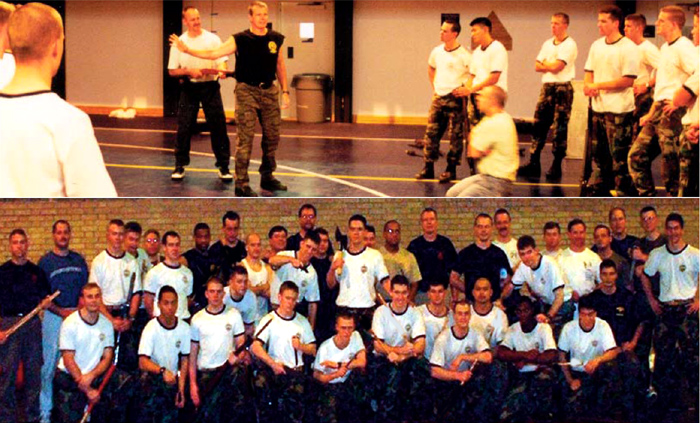
KO: Tell us more about that program.
HH: Well, everything is called “Force Necessary”. It’s based on using only that force necessary to win and survive. The definition of “winning” is different situationally and personally. I have a couple of rules about what a fight is. “Checkers, not chess” is a motto of ours, and defining what you don’t do, helps you define what you do do. Defining what you don’t wanna’ do helps you define what you wanna’ do.
Is a fight “chess” or is it “checkers”? I believe a real fight under stress is checkers for almost all people. I mean, look at the limited list of techniques you see in the UFC. So I have an internal meter in my head that can spot the chess applications. Einstein said, “Keep it simple but not too simple.” But the definition of simplicity changes with people. So, if you have a super talented martial artist, you should remember that their definition of simple, or “checkers,” is higher than the average person.
Trying to keep things simple and as realistic as possible, in the hand, stick, knife, gun realm, that is really core, essential stuff.
I am not going to create champion kickboxers. Or champion MMA people. Or champion BJJ people. And in actuality, a lot of those people that do advertise they create those champions…they don’t really create champions anyway. Y’know, they just have a program, and they do the best they can with it.
My goal is to create self defense people. And again, there’s of course that large middle realm of “normal” people. But then of course if you have a special athlete in there, you have to make sure you hit their level of simplicity, which is higher.
I can look at people and just decide what they need to work on. For example, here’s one example, I’ve tried to look into the subject matter of the density and size of fists. You can look at a person and say “You shouldn’t be punching people, because look at how tiny your fists are. Switch to palm strikes.” And then I have another friend who’s got fists like cinder blocks. And he needs to be punching everybody.
I just ran across this in Hungary last week, in Budapest. A kid wants to pursue all this information. And I can look at him and say “You need to take a couple studies of, like, how Bruce Lee moved. Because you’re small, you’re thin…ya’ know, you look like him. What’s your arm length?” Etc. “But you, Mr. Tank standing next to the kid, at 280 pounds, you should develop your own “bruiser” approach to this.
I can tell you many great stories. I mean, Dan Inosanto said in a seminar once, decades ago…and he was a high school football running back champion…he was getting the ball, and crashing into the line…and his coach said “Dan, why are you running into people all the time?”
So, he named somebody famous, but it was a giant running back…and Dan said “Well, I’m trying to be like my hero ‘Joe Blow’ (whatever his name was). And the coach says “Dan, Joe Blow is 6’4. You’re 5’ 7”. Pick…another…hero.”
And that’s a great piece of advice for people, so I try to keep everything in this system essentially “core” simple, and in the end it’s up to me and the people to make their own thing that works for them. And not try to pretend to be somebody else they can’t be. It’s the “who” question again. “Who are you, really?”
And then of course you come around to the subject matter of instructors. As an instructor, despite your shape and size or shape, an instructor must know everything. Because he or she is now in front of all shapes and sizes, and ages, and strengths. So there’s the question, is your guy, the attendee, someone who wants to defend themselves, or do they also someday want to be an instructor? Well, the instructor has to learn everything. Two-fold responsibility.
KO: Tell us more about your view on teaching punching in your system.
HH: Well, punching is cavalierly taught in martial arts without any warnings. The big problem is the “bicycle helmet” area of the head. That’s the real hand breaker. Because the jaw gives, the neck kinda’ gives, and you have some chance of surviving that without injury. But when the bad guy reflexively lowers his head…you’re aiming for the nose, you instead hit the bicycle helmet part of the skull…you’ve got a broken hand. Or say, versus a hook punch, they turn their head sideways and down, and you got the split knuckles break.
So that’s why punching is level 5 in our empty hand module, of the 9 training levels, because I think it’s taught way too cavalierly in almost all martial arts. I mean, in those schools you’re punching on day 1 and no one is telling you this could be bad for your hand and how to avoid problems. What about a palm strike instead?
I’m a puncher from day one, and my hands are not that small. And I’ve only had two real problems and one surgery, with a hairline fractured bone because of an uppercut to a jaw.
KO: How does knife/gun/stick fit into the world of martial arts?
HH: Well, I guess it doesn’t in unarmed systems. But it should. It has been connected, if you think back to the samurai. They were shooting guns at each other eventually. Because the human race, psychologically, has been built to kill from a distance. This has been proven and proven and discussed forever. Archery was the big deal way back when, and then guns. And it’s just harder, face to face close, to kill a person. Just, psychologically.
So, today, there are a lot of guns. I don’t teach marksmanship at all. I have interactive/simulated ammo shooting training. In situations. That’s all I teach.
And of course the real challenge is to shoot cold, meaning that you are suddenly attacked…at that point, what is your skill level shooting cold instead of your skill level on the fourth set-round, warmed up on the range…and they say even psychologically, preparing yourself to drive to the range…getting everything ready to go, driving there, entering the place…all results in you not being all that “cold”. All of that is starting to prep you to shoot. Warming you up. Instead of being ambushed. And being ambushed is the greatest trick of all to pull off.
So I try to have situations that are based on reality. And I have very safe, fake guns, and very safe ammo, and we are able to work through many repetitions of realistic problems. You’re not learning gun combatives unless moving, thinking people are shooting back at you. It’s just that simple.
Of course, this approach has been accepted now, by the military and policing, and some smart civilian courses. I started to do this in the 1990s, and people were hesitant about it, thinking the only solution was – “I just need to draw faster” and stuff, and now as time has marched on, anybody with any sense is exploring interactive shooting with simulated rounds.
And of course, everyone’s been fighting with some kind of impact weapon or sword, but I don’t know if these things are officially, classically, “martial arts”.
KO: How did being a police officer connect with all your training?
HH: Well, for one thing, I didn’t shoot a lot of people. Cause I could fight ’em. That was a big deal. There were circumstances where I could have easily, legally, shot somebody, and I knew I didn’t have to. And so, I didn’t. And that’s from all this training and realistic confidence. Of course, that was not popular at the police department, because it set a new standard for these other people.
I do know from the reaction of people that that was kind of a problem. I’d bring a guy in, handcuffed, that I could have shot, and some old timer would be at the police department smoking a cigarette…and he’d say “Why didn’t you just shoot that son of a bitch…?”
And I would simply say “I didn’t have to. I didn’t have to shoot him”.
So that was the biggest thing. My days, the ’70s, the ’80s, and the ’90s,…basically speaking, if you were toe-to-toe, face-to-face with a guy, and a fight really started, we would basically, legally, try to beat the shit out of them until he quit resisting. You can’t do that anymore.
Because here’s the deal…if you arrest someone and wrestle with them…which is extremely dangerous, especially on the ground…and you get them in a “submissions/tap out” hold…they’re not gonna’ tap out, because in most cases they don’t know how to tap out. But you’ve captured them. Because I’m telling you, when you let the guy go, he continues to fight. Or he runs away.
So the goal of submission wrestling in arresting people is really not good. Now, if two or three people show up…your partners…you can try to work that out…and it’s usually still an uncoordinated mess.
And I’m a big fan of catch wrestling. Because as a martialist, we must know everything about the body. And we must know every joint, which way they bend, and which way they don’t bend. It’s our responsibility to know that. That doesn’t mean I have to become a brainwashed wrestler. Judo people forget to punch. If you’re in a system that doesn’t have a complete, competent doctrine, huge chunks are out. And if you exist in that system for too long, you forget many important things.
The old school fighting ways were: you hit the guy, stun the guy, throw him down. And handcuff him. That simple formula did help me tremendously in policework.
Nowadays, it’s a whole different animal.
KO: How about the stick part of your program?
HH: I approach the knife, the gun, the stick, and the empty hand in the same way. In stick training though, if you remove the Filipino stick vs. stick fighting, there’s not a whole lot left to the stick study. A regular person is not going to be fighting with a 28 inch stick by happenstance. By happenstance, you’re standing on a street corner with a 28 inch stick, and you get into a problem with another guy who has a 28 inch stick? Not likely. At the stick versus stick part, that point the stick fighting becomes more of an art, more of a fun, abstract study, a hobby, and a martial art.
If you remove stick vs. stick fighting from the program, there’s not a whole lot of material. So, I work on that for the Force Necessary Impact Weapon: Stick course, we worry about self-defense survival. A little dueling, yes, but not at all like a Filipino course.
KO: And yet you seem to have a strong interest in the stick.
HH: Well, I started with the Inosanto world in 1986. Like so many people, Dan Inosanto changed my life. With the things that he was doing, and the people that he had. I spent a lot of time with Terry Gibson in Tulsa, Oklahoma, who Inosanto said was one of his top five people. I hosted Terry, I went to his house, I went to the seminars they did up there. I met Paul Vunak, Larry Hartsell, all through Terry Gibson. But part of the whole thing with Arnis is the overabundance of stick work, of single stick work.
As Ernesto Presas would explain, you really have five areas of so-called “play” in Filipino martial arts. There’s
So, sticks appear in three of those. Just naturally there’s an overabundance of it. Espada y daga is “sword” and daga, but it’s become “stick”, mostly. Some people justifiably call it “stick and knife”.
I myself am not particularly obsessed with sticks, ya ’know. I just have a long accumulated knowledge of stick stuff. And I have a world where customers want to see “stick” stuff. They are magically so interested in it. So, I am happy to do stick material, and it’s kind of fun and so on, but it’s not my main interest or thing to do.
And I’m amazed…I see these people that have weekend seminars, three-day seminars…single stick, seven hours each day. Wow! And they’re just hypnotized, and mesmerized, by stick versus stick. These people really love it.
And as a result of that, I am happy to do stick stuff. And frankly, I do know a lot about it. And Filipino martial. I’ve had lots of exposure, time and grade. Dan Inosanto, at first he was doing Pekiti Tirsia, and then he switched over to Lameco…and in the meantime, he’s still telling you what Johnny Lacoste did, what Serada does, and Illustrisimo…
I was exposed to all these different systems, and I started going to all these others with an open mind. I started going to Remy Presas seminars. Remy was charismatic, he was the real deal…he fought in the Philippines, and had killed people, in stick challenges, that’s not very well known, but I’ve written about it on my pages. So, I was going seminar to seminar. I was just a seminar attendee to him. And then some guy calls me over and says “Do you know about his brother, Ernesto?”
I said, “Never heard of him.”
And so, he said “Well, come back here behind this curtain.” And we started to do Ernesto material, and then I started to do Ernesto material for four years. As well as all the Inosanto material. As well as Remy material.
Then I get a phone call from my guy, and he says “I’m going to the Philippines for a month. You gotta go with me.” So, I’m thinking, I have hundreds of hours of comp time saved up as a detective. And you have to take that time after a while. So I said, “I’m in.” I’m a bachelor, I sold my car, we went. And there was only like 7 or 8 of us that went. It was great. Negros Island and in Manila.
The next thing you know, after about training in the Ernesto system for five years…on the last day, a black belt test and I get this black belt “guru” title, there in Manila. I come back with this lineage and an actual list of system requirements to do that was really elusive with other FMA instructors. Most people just had to spend a whole lot of time (and money) with “Tuhon Joe Jones” and maybe…maybe…you’d get something. I had a list and a lineage line straight to Manila. I said “You do these ten things, and you can get this belt ranking from the Philippines.”
“WHAT?!” they’d say, “You mean these ten things?”
Yeah! I said “I can do that for ya. And if you do these 25 things, you can be a basic instructor, as granted by Ernesto Presas in the Philippines.”
“WHAT?!”
So I started to become popular because I was, I had this connection. Back then, everybody wanted a backyard workout, a garage workout. Some guys rented a space. But everyone had a dream that was financially hard to do as time marches on. And that’s really how I became so-called “famous.” I started touring all over, people started asking me to these 10 things, to do these 12 things.
Meanwhile, I’m still with Remy Presas. Again, at those early times I was just another seminar attendee to Remy Presas, and Remy finds out I’ve been to his house on the Negros Island, that I’m working out in the Philippines, he contacts me. Then he and I became close. He knew I cared that much to do all those things. I hosted him numerous times and he stayed at my house a lot.
Both brothers had similar systems, but they’re different. Ernesto’s is much bigger. Ernesto was obsessed with making the perfect Filipino system, in those five areas of play. And as a result of that, he was tortured, and he never could complete it. He was constantly changing it, constantly messing around with it. Whereas Remy just wanted to do enough so that you could fight well, basically.
Both these guys were Karate black belts, they’re Judo black belts, they spent their entire lives doing martial arts. So. they were very well versed. They could fight anywhere, with anything.
But, back on the stick subject, as time marches on, the obsession with single stick with people is amazing.
So that is my…not a love/hate, but a love/infatuation with sticks.
KO: You’ve written quite a few books, right?
HH: Well, I have a very popular knife combatives book…
KO: (Thumbs up. I love that book.)
HH: …It’s got about 1,400 “how-to” photos. It’s very popular, it sells regularly, and now it’s an e-book.
Then I have an impact weapon book, which is not based on Filipino stick. But it is the blocking, striking, and grappling with an expandable baton, or any type of impact weapon that you have. I’m in the middle of making an unarmed combatives book, which is gonna be another heartbreaker to make…2,000-plus photographs, as much of my knowledge on the subject as possible I can record.
Then I have to do a Force Necessary: Gun” combatives book, which is nothing but all the sims ammo, interactive scenarios that I teach.
Those are the “big four”. The idea of writing a Filipino martial arts books is just overwhelming. I get a kick out of seeing these guys who write a “Filipino Martial Arts Book”, and it’s like a 128 page book. No (laughing), it’s gotta be as big as a damn spaceship manual. Now, I could do a five books on the five areas of play, that is digestible, possible. But y’know, I’m 70, I don’t know if I’ll get to finish ’em. And then of course, I do write novels, and I have a western series, and I have a detective series, and those take up a lot of my time.
KO: With modern technology, how important are books to the modern martial artist?
HH: Well, I guess that videos are superior, because you get to see what’s happening, but historically books are still important. They used to claim there were five ways to learn something, visually, reading, doing, etc. I don’t remember the others…but I’ve forgotten them because other experts have come up with five or more, better, ways to teach and learn. The original “five ways” is kind of an old school mythology that fell out of favor. I do know that you have to have different routes to people’s brains to teach them.
So, videos are pretty important. Sometimes I wish I had a GoPro I could plant, real thin, right between my eyes, and do what I’m doing and show people my (their) point of view, our perspective. And that would be another important way to learn.
But, for many, one of the main methods of learning is a book. And that’s why when I do these combat scenarios in books, I try to do each important step in the photos.
I’ve made about 45 training films. But with the demise of training films and the shortening attention span versions of films you see on YouTube…pretty much, the one-hour training video has lost the ability to be sold. Like Paladin, once a big international martial arts video company has collapsed. Century has bought the Panther videos but they don’t seem to be selling them. Nowadays, if you have an itch to learn…say…wrist locks, you type it in, you watch 17, three-minute YouTube videos on wristlocks, and you are sated. You’re not gonna’ buy a $40 wrist lock video. So, that is the problem with bothering to make movies anymore.
Of the 45 movies I’ve made, many are now free on my YouTube channel. I’ve decided once a month, I’m gonna put a 50-minute to 1 hour video up for free on my YouTube channel. Because of how things are changing. I don’t want the videos to sit and rot. If I was rich, I’d do all this for free anyway. That way at least people can watch and learn something.
KO: Are there any martial artists/martialists/fighters that you look/looked up to?
HH: Well, y’know, I really like Bas Rutten. I wish I could spend about year with that guy. But there are others that are competent fighters. I know that Bas will tend to lean toward the MMA/combatives thing, but he’s a pretty smart guy. Eric Paulson is amazing, the JKD guy. He’s amazing. He doesn’t seem to be hypnotized into wrestling. He knows the big picture. The information in the big picture is constantly on the tip of his tongue. You can always ask him “What about this? What about that?”
Gosh, and through the years, there’s been so many, but in particular categories. Scott Reitz. A founding member of LAPD SWAT…there’s your gun guy right there. Paul Howe, former Delta Force, gun guy, teaching in Nacogdoches, Texas. I guess I tend to lean towards extremely experienced people.
And then, some of the smartest people in the martial arts that you will ever meet, will run a quiet little school in a strip mall, in “Bumscrew”, Wisconsin. And nobody knows about them, but they’re brilliant people. And that’s just the way that it goes.
KO: What are your hopes for fight training, combatives, martial arts, etc. in the future?
HH: The bottom line is that I hope that everyone will be happy doing what they’re doing. Because much of it is a sport or a hobby.
The only thing that I ask for, that I ask and dream of, is that everybody who’s doing their hobbies and sports realize where it fits in survival. How does it fit in? Does it fit in? That’s one of the “who, when, what, where, why, and how” questions.
You have to have a martial IQ. The intelligence quota, to select the right things, and keep improving. If you wanna wrestle the rest of your life, and you still realize that this isn’t the cure for all fighting, and realize you don’t have a stick/gun/knife involved in this, and notice if you have forgotten how to punch and kick, “I just know this wrestling thing, and I love it! Maybe I will do a sports tournament thing someday, wouldn’t that be fun…”
Yeah. Go. Have a blast. Just know where everything fits or doesn’t fit. In the end, I want everybody to be happy with what they’re doing. They’re off the couch, they’re exercising, they’re part of the social aspects of a good school…you have Christmas parties, get togethers, you have kinship…all these great things can happen because of a martial art class, or a combatives class, or whatever. Just have an idea, from someone, somewhere, where your art fits in real life. And then, I’m happy. If you’re happy, I’m happy.
KO: Do you have any advice for martialists or Kajukenbo people in general?
HH: Well, Kajukenbo is, to me, a wide-open system of learning. They want you to exist in those categories and keep evolving and learning. And that to me is the best advice. Keep evolving and learning.
Hawaii was an amazing place, and a transition for so much.I remember Ed Parker saying that he tried to take all the Karate and Kenpo and turn it into an art for a bigger person. To Americanize it, so to speak. I think Kajukenbo did that too. And now it’s one of those martial arts that’s all over the world.
Back then there wasn’t a lot going on. And the arts there in Hawaii were the established beginnings of things. So, it doesn’t surprise me that a lot of guys were in those two arts (Kenpo and Kajukenbo). Nowadays, the popularity to me seems to be with BJJ and Krav Maga. You don’t see the Kung Fu school so often anymore.
To read more interviews like this, be sure to check out Kajukenbo Okayama’s recent book, “Blood, Sweat, and Bone: The Kajukenbo Philosophy.
https://www.amazon.com/stores/John–Hojlo
THE SACRIFICE FALL Pride before the “Fall.”
Pride before the FAIL (or Fall) – meaning “those people who are overconfident or too arrogant are likely to fail” – this quick, popular and easily understood saying is from the Bible’s Book of Proverbs, in a few varied words. But the same message. Now, I am far from a Biblical expert, but its general popularity speaks volumes. Here I would like to rotate the word “fail” to “fall,” – which so many people already do anyway. There are other related phrases to add to this subject, like “you fell prey to,” or “falling prey to,” meaning you have been misguided and “fell” for some such thing that you should not have.
I would like here to produce some ideas and regenerate some martial arts history. The subject? The so-called “sacrifice fall” or another version of the same, “sacrifice throw.” Same-same.
The word “sacrifice” pops up in many ways in old and new combatives, martial arts and combat sports:
Yes, lots of sacrifices in the martial arts and combat sports. And in this category of sacrifices includes the ubiquitous topic of “sacrifice falls” – defined as “purposely giving up, surrendering, your superior standing or knee-high position to end up fighting on the grounds and floors of the world.” I am here to report that once popular warning, is not at all as ubiquitous as it once was. And I would add, numerous popular arts and sports seek the very opposite. Entire systems now live on and for the sacrifice fall. I mean why else call them sacrifice falls for God’s sake! You are sacrificing,
Starting as an adult in the early 1970s in Ed Parker Kenpo Karate, I was taught the old, current and potentials of fighting. A common expression and lessons were about serious warnings on the “sacrifice fall-throw.” It was once very popular to at least warn practitioners about the few pros and mostly cons of sacrifice falls. “Now this technique is a sacrifice fall. You will go down on purpose with your opponent, sacrificing…”
Much of this early aikido, aiki-jitsu and jujitsu training was down on wooden floors or carpet. Falls were tougher to absorb than on today’s mats. This was educational. To my memory, these instructors never said, “Don’t ever-ever sacrifice fall!” There are indeed oddball times when you should, but they just warned you about the losses.
Warned you about what exactly? Loss of mobility. Multiple opponents. Hard landings. You know the drill, the usual advice, now so ignored. And like worrying about the varied surfaces of the world include the wood and the carpet, yes, but also cement, asphalt, tile, sand, dirt, water, mud, rocks all found within the vertical challenges of slants, stairs, hills, surrounded by furniture, bars, walls, trees, fences…well…the list is long and in some 26 years of police work in line operations, I have struggled with suspects in many of these horizontal and vertical mixes. (One of my “memorable” arrests was falling and fighting a suicidal guy in the pouring rain, sliding down a long, very slanted hill of mud. We weren’t standing, nor officially horizontal, we were “down.” Is that “ground fighting?) I once got a bruise on my rear end, fighting down on a parking lot, from the badge inside my wallet, in my back pocket. That’s reality. It does also stand to reason that…I have NEVER fought a suspect…on a mat. the world is not a mat, It’s a tough surface.
I know this concept-advice is old, but is it gone? It is still rather ignored by thousands, so the drum must be pounded. Recently, I saw a film of one my acquaintances-teachers jump on an opponent in a tackle and they both plummeted onto a very plush, deep (6 inches or more?) gymnastics-style mat. It was blatantly obvious that our hero would have totally shattered his elbow. I said, “damn, and he doesn’t even know that?” He must not have known because he proudly published the film clip. Finally, someone chimed in with the comment, “and you have now totally destroyed your elbow.” Ahhh, just one of the perils of the purposeful, sacrifice fall. The instructor stuttered a half-assed “yeah…we…but…ahhh…” reply. There was no getting around the mistake. He should have just taken the clip down off the web. He should have had the “martial I.Q” to realize that his “cool-breeze” move was a contradiction to the “SELF DEFENSE” verbiage on his storefront window.
I do not wish to bother you here with list of advantages of being up and mobile, with a solid expertise in kickboxing, facing the mixed weapon world of hand, stick, knife, gun. I do believe everyone knows this on some level, but they do not actualize it, take it to heart and mind. So many arts and sports these days ignore or de-value kick-boxing, and work hard to only achieve a sacrifice fall, only to wrestle on the ground for a submission. Their sport-art training mission is central to sacrifice falling. You must go down with them. There are videos for sale out there proudly titled “The Best Sacrifice Throws.” Yup, for sports and arts, but there is a certain, cancerous, brainwashing, muscle memory about all this. Recipes to fight survival are situational.
It use to be joke-videos years ago, when we saw submission fighters drop on the ground and shout “Get in my guard!” It was funny! We laughed. Now, this is actually happening in competitions! Why bother with sacrifice falls! Just jump down and get in my guard! What an abstract, rabbit hole.
Old police college researchers tried to compile a list in the 1990s on how we end up on the ground in a fight. It makes some sense. In order they advised:
Years ago, like in old school ju-jitsu , the priority takedowns were those where you remained standing up or at least knee high. You tried. Even in police work arrests, you tried. These are indeed a little harder to do. It is often easier to sacrifice, to just jump on someone and both hit the mat. I mean ground. As a teacher of self defense, these distinctions are in my course doctrine. Our first line of takedowns and throws involve set-up stunning strikes (it all starts with something like kickboxing) and takedowns where the practitioner remains standing or knee-high.
A defender must fully learn ground n pound, survival, no rules, ground fighting for when one accidentally falls or is taken down by a criminal or enemy soldier sacrificer. All survivalists, all martialists, must learn every joint in the body and which direction that joint turns and bends and which directions those joints can’t-don’t turn and bend. Standing through ground. This general, body-knowledge is required.
Ends justify the means? In 26 years I have arrested some 900 people and been around for and investigated hundreds more “fight enders”. The martial arts? 51 years and counting. I can predict how these things end. Many students seek the sacrifice fall to seek the tap-out submission, a recipe for sports and arts. Fun for all to know, but when soldiers, civilians and police drop and seek a tap-out submission in a conflict, this is NOT a fight ender. When you let them go, as you eventually must, the fight (or chase) continues. Dumb martial artists claim, “I’ll break their arm then…etc.” Dumb combatives people claim, “I’ll blind them, then…etc.” Then bubba, you’ll probably go to jail, taking an arguably self defense situation into a serious bodily injury felony. By the way, police must be in a limited, somewhat submission position to handcuff. Handcuffing resistors-fighters is hard. They punch, kick and bite.
Let’s not sacrifice words, in a summary: Have you ever known of, or have forgotten the almost ancient advice-warnings on the idea of sacrifice falls-throws? The tip, the advice still does exist in smart places here and there. Recently the Evolve -MMA.com (a great resource) page warned – “Remember that the sumi gaeshi is a sacrifice throw; an unsuccessful attempt may result in either a pin or a scramble.” The advice-warning still is in existence, but not enough.
Now look – I always run this disclaimer – if you are a happy camper in your beloved hobbies, arts and sports? Judo. BJJ, tennis, golf, etc? Great news! I’m happy if you are happy. All I ask is that you know those are abstract skills relate to reality. Just know precisely what you are doing and where it fits in the real, big picture of hand, stick, knife and gun, war and crime survival. It might not fit much at all (this might mean taking down the self defense sign in your window). Don’t spread the innocent, cancer-brainwashing. Don’t advertise that your mandatory, sacrifice fall, submission, tap-out art is the superior system of the planet. The galaxy. You have then “fallen prey” to short-sighted ignorance. Your martial “I.Q.” is low. Don’t fall prey to the sacrifice fall.
And to back a bit to the bible analogy – “People who are overconfident or too arrogant (about their ground wrestling, who ignore kickboxing and mixed weapons, who ignore crime and war) are likely to fail-fall.” Pride before the fall, the fail.
_______________
Get Hock’s monthly free Survival Centrix newsletter. Get on the list of thousands who do so. Email Hock at: Hock@SurvivalCentrix.com
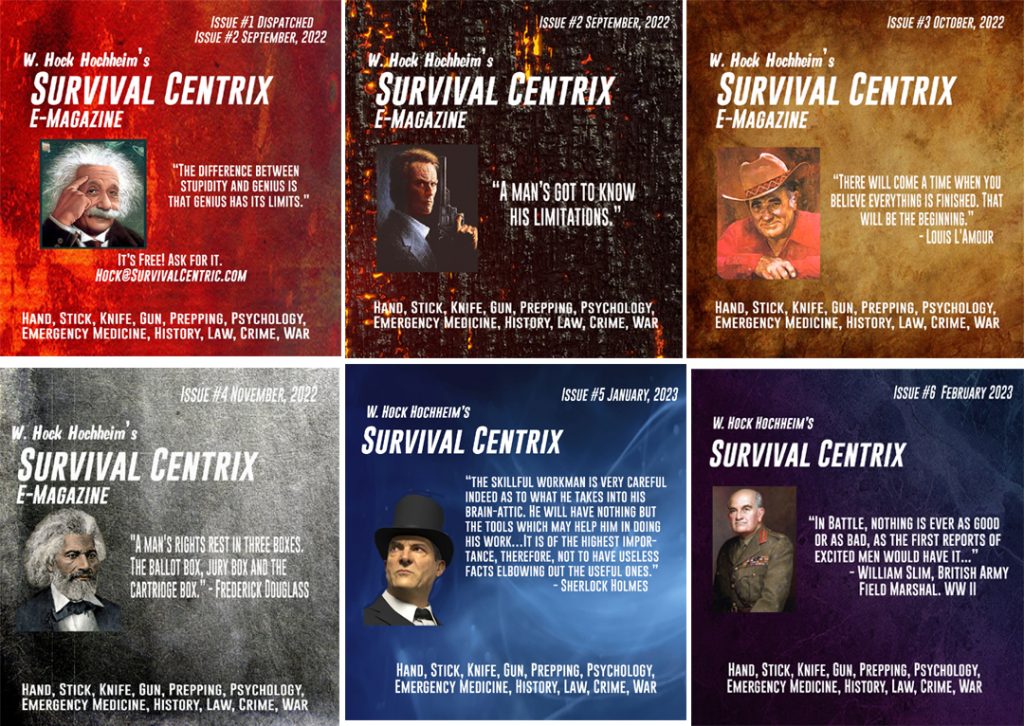
In That Small Café…
In my Budapest hotel this week, arranged by my seminar hosts, I stepped outside for the first to look around. Right across the street was the rear of a magnificent classic building. Such sights are not unusual in Hungary. Weather just beautiful, I stepped to the right a bit, and I discovered that this was an art museum and that it was across the street from a giant circle of historic Hungarian statues of heros. And I realized I had been here-there about 7 years ago, not just “I”, but “we”…with Jane. Spent hours there with Jane.
I was suddenly a bit short of breath, and a sense of “wow” and bittersweet came over me. Bittersweet is what you wish for, a sense of “sadness-mixed-with-great-memory, touch-of-happy-gratitude.” Complicated emotion, huh, once dissected. We’d been inside that museum and on the circle. I walked around the area and saw the sidewalk café we sat in for coffee and a dessert that late afternoon. The café is still there, along the way. Across. And then the bittersweet turned way more bitter. And bitter.
I walked past it, gapping at it. A musical phrase rang through my head over and over, “in that small café…in the small café…” What song was that? I knew the rest of the lyrics would pop into my brain when it cleared later.
But I had to pass the café again on the way back. I saw couples sitting there at the tables and I felt compelled, driven to approach at least one pair, and tell them to deeply SAVOR this simple, everyday moment in time, in life because…because, someday only one of them might pass it by, alone like me. Do any of them even speak English? They might think me a crazy bum bothering them? I didn’t try. I left with only deepest sadness. I returned to the hotel.
“In that small café…” What, what was that…
The next day, near the café again the full song came to me like magic. Of course! It is a harrowing song, a heartbreaker sung by many greats. Sinatra. Durante. Many. I had always thought it just a song about a failed love, but it is also truly about a death.
I’ll be seeing you
In all the old familiar places
That this heart of mine embraces
All day through
In that small cafe
The park across the way
The children’s carousel
The chestnut trees
The wishing well
I’ll be seeing you
In every lovely summer’s day
In everything that’s light and gay
I’ll always think of you that way
I’ll find you in the morning sun
And when the night is new
I’ll be looking at the moon
But I’ll be seeing you
I’ll be seeing you…
These “small cafes” are everywhere in my life, in your life. As I have said before, with great love is great catastrophe. For the one left behind. The ones left behind. I await the bittersweet. Will I ever fully feel it? How many of these love-lost songs are also about death too? Can I ever listen to music again? Will I ever get to just smile at such memories and not break down? Experts and well-wishers tell me I will. I just don’t know.
I wish I could be more positive for you here, but I do know at least this, think about this message when you and a special someone sit at that simple, “small café across the way.” It’s never so simple and not so small.
|
Decades ago, I was working out with karate expert friend, and I grabbed his arms. He’d never been grabbed like this, and he had the epiphany-realization in that moment he needed grappling. But he then started years of Judo. But, this was yet another sport-art. They are both sports-arts. Combining them is still two isolated segments of sports-arts, each deficient in their own categories. Adding and doubling, tripling up on more sport-arts atop each other is not going to best solve the survival problem. It complicates it. It distracts it. It needs blending, not adding.
I see a lot of Mixed Martial Arts being taught and spread. This morning I saw a school advertisement for a “Boxing and Ground fighting” school. Their attached photos show official sport “boxing” and official sport Brazilian wrestling. I get the idea that the advertisers, as well as the customers must think…
“Wow! That’s so complete. I’m getting both.”
“Ready to be attacked by any and all!”
Combatives is supposed to be above all this isolation. But, once you accept the combatives mission-mindset you are faced with the next problem. Collecting and cleaning up the material, material that mostly comes from sport-arts! And you must possess the “martial IQ” to evaluate the material. This process is not as easy as it sounds. It needs blending, not adding.
Try if you must, there is still much sport leakage around. Even in some Krav Magas – present supposedly as a final cure for sport leakage, but I still see…sport leakage, naively, accidentally falling back too far into sport-art. Instructors are often brainwashed from their old art-sport systems. They still think and solve within their brainwashing when there might be a better, faster, unbiased way. Hey, I still find more of this cleansing about every week – “Why am I doing this when I should be doing that.” The process never ends.
Some things the “Ws and H Questions” for you to ask and answer…
* WHO are you?
* WHO is the instructor?
* WHO do you want to become?
* WHAT are you seeking exactly? Precisely?
* WHAT – is there a better, faster way?
* WHERE do you go to seek your result?
* WHEN have you really found the “it?”
* HOW will you find “it?” How do you or he dissect “it?”
* WHY are you motivated to try?
“Learning different martial arts is pretty much useless in modern MMA. It is now its own sport and anyone interested in learning MMA would be much better served to join an actual MMA gym. Learning separate martial arts before starting MMA would be, quite frankly, a waste of time.” – Sprawl CO.
Modern MMA as we see in the UFC etc, is the closest art-sport you will get to reality. But you still need to add weapons, cheating, delete safety rules and weight classes and worry about trying all the moves of these full time, young professional fighters. I’ll bet you are not a full-timer, young professional fighter-athlete – 99.99999% of us are not – so you probably can’t and shouldn’t try to do what they do.
(And of course people have hobbies and they want to pursue their hobbies for a variety of reasons. They should answer those questions, know what they want to do and its limitations. I just ask, do they know what they are doing? If so? Hobby, hobby, hobby on and be happy!)
____________________________
Get the collection of essays found in Fightin’ Words. Click here
Boys and girls! Another episode in the thrilling days of yesteryear Texas Policing….
When I walked onto the Criminal Investigation Division floor to start my evening shift, I could tell something was “up.” The day shift guys were scrambling to get their tactical vests and assorted personal gear and standard-issue, shotguns.
“Hock!” said one, “Hurry up here!” and they directed me up to the third floor meeting room, which was a large room constructed like a small theater.
“We will hit this house….” …and the briefing went on, conducted by a new sergeant who also was a traffic cop at heart promoted to detective sergeant in the foolish card shuffle I call the “admin police fandango.” I’ll just call him here, “Sgt Larry.”
Down in our city’s projects, in an old, two-story wooden, house bound for demolition, a local crack/cocaine dealer, ex-con named Willy Vics was running a dope house. It was a magnet for bad guys and hookers from the region. Our narc guys had a freshly signed warrant in their hands, growing stale by the minute.
“David, Benny, Jeff…you three will enter here and will move upstairs…Tony…you…” and Sgt Larry laid out the plans. There was a somewhat discreet effort to rest the SWAT team a bit in those days. Recently, a certain team had set a house on fire with a flash-bang that – once shot through a window, ignited a curtain, and the ENTIRE house burned down. And, well, there was a movement, you might call it, to tone down militant appearances. Some line operators finally started asking the question, “Do we really need SWAT to do this?”
At some point, someone in the fandango decided regular detectives should do this one, not our SWAT team. This was reminiscent, pre Sgt. Larry and of the pre-SWAT days. We detectives were once the “SWAT team.”
So, his chalkboard was filling up with tactical brilliance. White arrows were laid down aggressively, but there was a bit of a problem manifesting. Call it – “the back.”
You see, the back of the house emptied out to a big yard beside a side street and connected to a neighborhood of other yards. On the board, the arrows ran out of people to cover the escape routes! I would say there were at last six detectives assigned these arrows. Sgt, Larry looked up at newly arrived me, gearless at this point and still in the required suit and tie-
“…and Hock…you take the back.”
Huh? Famous last words. Okay. Me The back. Take it. Pretty big back “take” though. A few of us had run dozens of these deals through the years and we all had “taken the back,” at one point or another. Still, this was a pretty big “back.” Nothing new here, though. Most of the time, the suspect, and or suspects, upon hearing officers at the front door, would then peek outside a rear window, see a troop standing guard back there, and often surrender. Usually. Some hide in the house. We still had had to chase a few. I would often put something across the back door causing a fleeing felons to trip. There’s a few tricks there I won’t reveal. I witnessed one investigator throw a brick and hit a fleeing suspect in the head. Took him right down. He couldn’t shoot him! So he bricked him.
Within a few minutes, everyone hit the streets in their unmarked cars. I threw on my body armor and raid jacket and left the shotgun in my car (too cumbersome in close quarters for me on most deals of this nature). The plan was to give me a minute to park down the street just a bit and trot up to the yard. This was a corner house. Then =once I was ensconced, several cars would skid up to the house front, men bail out, destroy the door, and rush in.
I barely had time to jump the very tall, pre-demolition, chain link fence, when I heard the sound of skidding tires and men yelling out front. The usual soundtrack. It is always tricky to exactly coordinate these things.
There were about six back windows and a back door. The first floor extended out beneath the second story. This extension made for a sloping, large ledge under the upstairs windows. I tell you this now because in an instant, every hole in the back of this building had people pouring out of it, out the first floor door and windows as folks leapt, hung and dropped from the ledge to escape. And here they came!
“Halt! Police! Stop!” I yelled from the middle of the yard, my .45 drawn. HA! I recall at least 10 unarmed people ran by me as though I was not there. Fat hookers, skinny dopers, teens and old fogies. You name it. If I had actually started shooting at them? Well hell, I’d be writing this from the penitentiary right now.
BUT! One of the escapees was Willy Vic himself! He ignored me, too, so I figured since he was the subject of the entire raid, I would chase him. The sprint was on. Willy had to vault a fence, and I was counting on that slowing him down. I holstered my weapon. I couldn’t shoot anyone here anyway.
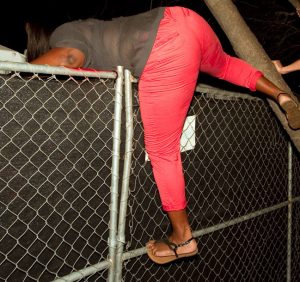
Thereupon came the scuffle. Willy landed on his back and my mission was to get him cuffed, which he didn’t want either. He still had “rabbit in him” (which was Texican lawman talk for he was a runner).
He was a big guy, but in his mid-50s and these guys are still dangerous when excited, plus I was rather surrounded by his escaping customers and his gang who could double and even triple the odds in Willy’s favor. Ever try to fight a mean, angry, fat hooker while trying to handcuff someone else?
Meanwhile, the “team” was cautiously SWAT-tip-toeing through the house as though terrorists with sub-guns and bombs were behind every corner. I could hear them yelling, “Clear! Clear!” as they secured every empty room and closet in the 2 story house.
One thing was very “clear” to me, I was all alone in the yard, fighting a guy right beside all his buddies, who I hoped were all busy trying to escape. I had to toss a few snappy body punches into Willy, all the while yelling for him to give up. He quickly ran out of gas, and I muscled him into cuffs. His passing help? There was no loyalty among these thieves, and all the escapees got over the fences and were log-gone daddies. Some climbs I saw were comical. I stood alone with the drug dealer, and I was, all at once, a failure and a success in my mind.
I pulled the portable radio out of my back pocket and called Sgt. Larry. I reported that I had caught Willy Vics in the backyard. I hooked his arm, lifted him, and walked him through the house to the front porch where the dopers who were caught in the front rooms were cuffed and sitting on the steps. It made for great front page, local, newspaper photo of about six guys, now Willy among them, cuffed and sitting dejected on the front porch steps and about six of our guys in raid jackets and shotguns towering over them. What a picture. What a photo op!
I stood off from the victory photo-shoot and was a bit disappointed in myself because I had let about, oh, 11 people get away. I was about 29 or 30 years old then and had very high expectations for myself. Hell man! “One riot? One Ranger!” Audie Murphy and Sgt. York took hundreds of prisoners. I couldn’t stop ten dopers and four fat hookers?
But, it all became quickly apparent that, in the end, I had caught the big fish they were after, and there was a tactical mishap in planning. Being me alone…”taking the back” – you know, the place where everyone seems to go when the front gets raided?
This mishap became an “inside joke” with the troops for awhile. For the next year or two there was running joke with CID that anytime we would plan anything, (even a football party), it would finish with, “…and Hock, you take the back!”
Sgt. Larry really was a traffic cop at heart and no Kojack. (This is a common problem in policing, promoting football players into basketball games and vice versa. He returned to that position after much negative ado.) If he heard the rib, he took it with good nature. I guess?
There was an old 1960s comedy bit done by the now disgraced Bill Cosby about the Lone Ranger and Tonto. (I once loved Bill Cosby.) The Lone Ranger would say, “We’ve got to go to town and find out what the gang is doing,” meaning that actually Tonto himself, – alone, – would have to go to town. Whereupon he would routinely have the snot beaten out of him. Bill Cosby said he and his young pals would scream at the TV set,
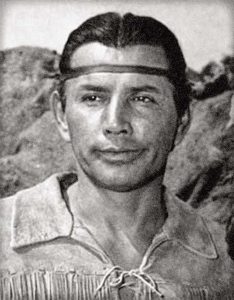
Cosby suggested Tonto say instead, “Who’s ‘we,’ Kemosabe?” Which for a while back then, that line become a bit of a cultural, well know joke. You might still hear it a bit now.
But that one day? I was Tonto out back for sure. And Kemosabe was nowhere to be found.
_______________________
Hock’s email is Hock@SurvivalCentrix.com
This story is excerpted from Hock’s Dead Right There book and appears in the Wolfpack E-book Omnibus Kill or be Killed, click here for more on these books.
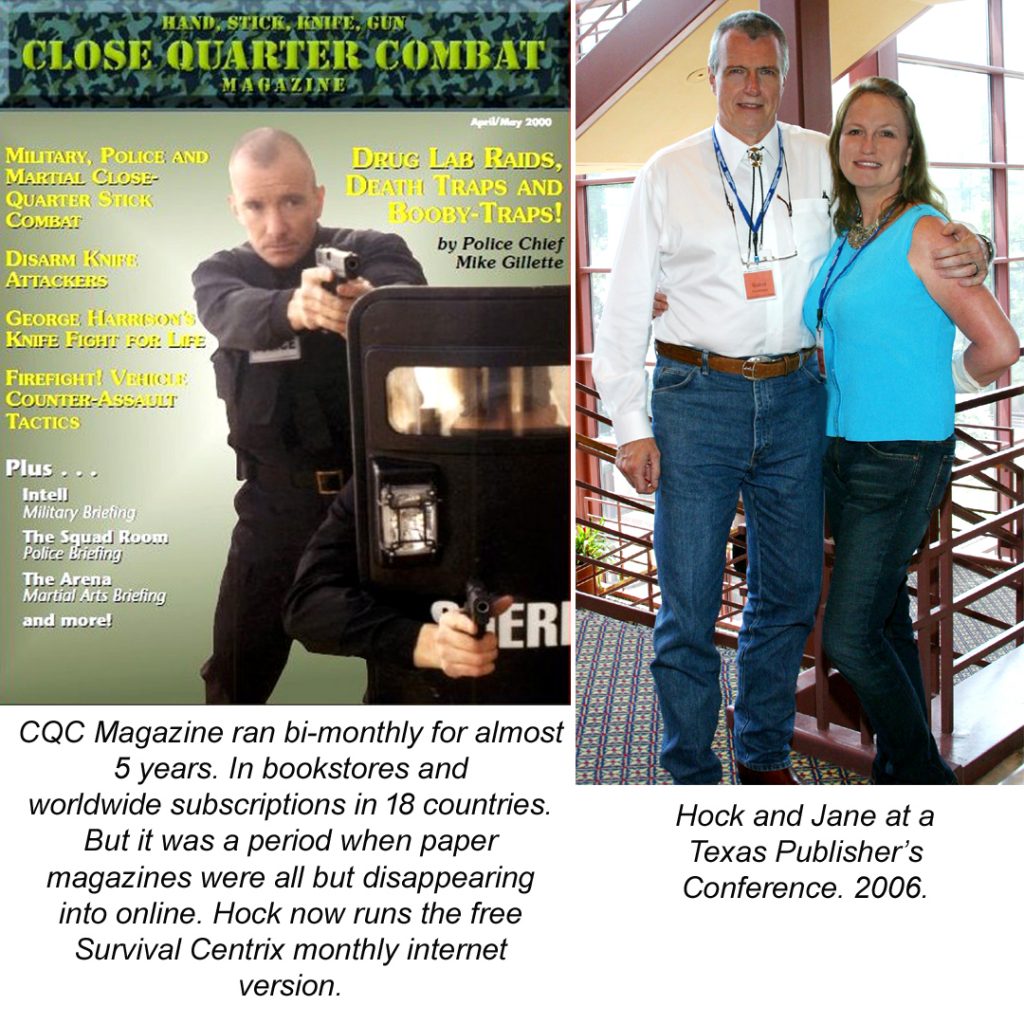
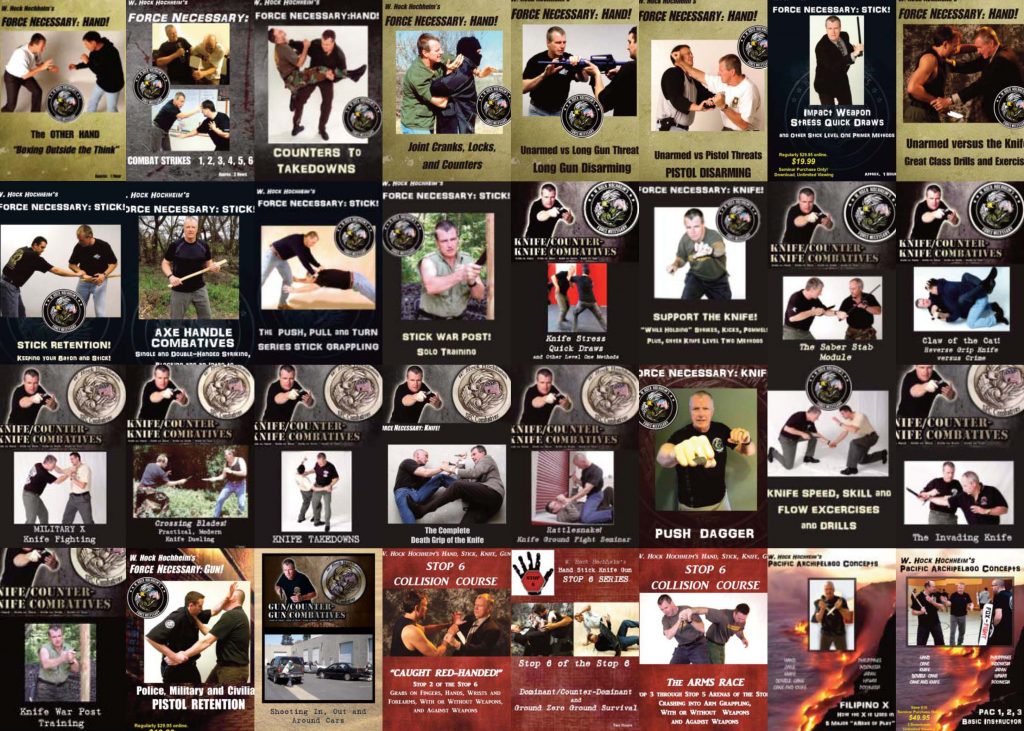
Attacking the Neck for Restraints, Takedowns and Chokes
A martialist must have a working knowledge about the anatomy, physicality and the law when it comes to wrapping arms around the neck for any reason, a walk-away, takedown and/or any choke. Here is quick, mandatory report on what you should know on the subject in general.
First, I would like to establish my anecdotal experience. I am from an era, starting in the 1970s in martial arts and police work where chokes were very popular and roughly trained. A choke was a go-to, common enforcement move and in 26 years I have choked out about 10-12 or so people. That is not a lot, As an obsessive martial artist, training and experience has helped me use alternatives to choking. But I have witnessed and partaken in some 40 or more. Every suspect quickly recovered as we were taught to monitor the suspect’s responses. And I have been attacked by a few chokeholds, most during during arrests (read on for the worst). And in those olden training times, it was not uncommon to be accidentally choked out (and knocked out) sometimes in class. Times have changed.
Chokes were treated very flippantly in those olden times. Sadly, in the recent decades that followed, for whatever reasons – be they a lack of knowledge-training, etc., simple chokes have caused damages and deaths that have enraged into socio-political, national and international uproars. You do not want you or your students, compatriots and-or employees to be a part of such uproars. Results may include imprisonment these days, by ignoring the facts. Chokes are risky yes, but, still, a martialist must have a working knowledge of chokes and non-choke, neck grabs.
While such sport-choke and related sport neck takedown methods are useful to practice and know, they are small in comparison to self defense, crime, law and war problem-solving. So, this subject-study will include civilian, enforcement and military realities, as well as generic, applications of arm wrap, chokes and neck grabs.
Due to popularity and fandom of martial arts sports, most of the neck-related, training attention, time-hubris is spent on sport tap-out chokes down on the mats to win matches and pro fights. This sports version eats up “all the oxygen” (if you will pardon the pun) in youtube videos and internet searches. Several martial arts will claim there are “100s” of chokes, but no. Instead, there might be hundreds of chess-like approaches and situations to inch into these chokes. The choke itself is “checkers simple.” Blood and air.
And important – all neck attacks are not chokes…however, neck attacks are loosely, flippantly called “chokes” or “chokeholds” by many. We’ll be looking at the common arm-related ones not crushing-hand chokes, but crushing hand chokes might cause similar injuries as arm wraps.(It should also be noted here that choking by the hands not arms is a very big domestic violence problem. That’s another essay. But generically speaking, the injuries are very the same.)
The big two… for our rear arm wrap attack and takedown essay and yes – as well as grounded problems, here are two main neck arm-wrap-grabs for rear chokes and takedowns. See the drawings below, single arm and double arm wraps. You will find there are numerous nicknames for chokes. Some do help identify the move-position. Blood chokes are often called “sleepers” because the “chokee” thinks he is really just neck-uncomfortable and still okay… and… and… he’s out. While an air choke will probably cause the chokee to “air swim,” like he is drowning on dry land.
What are the legal and medical definitions? Law Insider defines a neck restraint as “the use of any body part or object to attempt to control or disable a person by applying pressure against the neck, including the trachea and-or carotid artery with the purpose, intent, or effect of controlling or restricting the person’s movement or restricting the person’s blood flow or breathing, including chokeholds, carotid restraints, and lateral vascular neck restraints.” (For the record, a “Lateral Vascular Neck Restraint® (LVNR®) is a control technique applied to the sides of the neck, using a combination of physiological factors to restrict blood flow to the brain which may cause the subject to lose consciousness.)
Dr. Google defines choking as a strangulation. “Strangling cuts off the flow of oxygen to the brain in one or more ways. Strangulation compresses the carotid artery or jugular veins, resulting in cerebral ischemia. Cerebral ischemia is caused by disruption of the blood supply, and thus oxygen, to the brain, particularly the cerebrum. Global ischemia is caused by cardiac arrest, shock, carotid occlusion,hypotension, asphyxia, or anemia. Focal cerebral ischemia is usually related to cerebral vascular atherosclerosis. Strangulation is defined as asphyxia by closure of the blood vessels and/or air passages of the neck as a result of external pressure on the neck.”
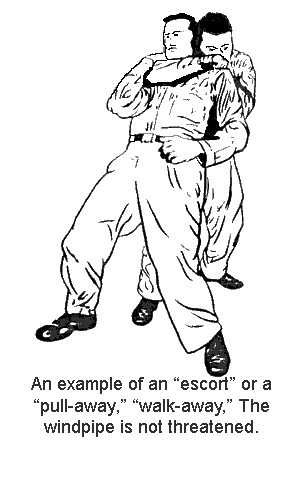
Tick-Tock…. In May, 2023, a former U. S. Marine interrupted a disturbance and threats on a New York City subway with a choke, one that according to witnesses the hold lasted 15 minutes. The person died. The Marine disputes the time length and denies lethal intent, but nonetheless the man died. This caused a serious socio-political incident and put the Marine under indictment for murder. One must be very cautious when doing any neck wrap choke-contact for criminal and civil problems. Did a restraint slip into a prolonged blood choke or an air choke? Did the hold last too long?
Very Well Health reports that, a “A medical evaluation is crucial if someone’s been strangled. An injury to the trachea may not appear to be serious right away, but swelling in the tissues around the trachea can lead to a secondary restriction of airflow a few minutes after the neck is free.”
So how long can you squeeze? Police files report officers that have blood-choked suspects held for 30 seconds have died. That’s a short time. But shorter times are on record. There are other times the suspects hang on, struggling for longer. The old and general advice with a blood choke is to monitor the opponent. You can feel when someone “goes to sleep.”
How long is long then? “A 17-member panel of submission experts (including BJJ black belts, experienced grapplers, former MMA athletes, and medical professionals) analysed 81 UFC matches between 1993 and 2020 that ended in strangulation submission due to a LOC (as opposed to tapping). Each examiner reviewed each film (blinded to the other’s interpretation) to determine the time between full application of the technique and LOC. The mean time to LOC was 9.0 seconds, with a standard deviation of 2.5s. (Note: this had to have included ground chokes and this section of Level 2 takedowns is only covering standing rear arm wrap chokes. Still we can glean related information.) These results were consistent with previous studies in compliant volunteers, indicating that skillful application of a choking/strangulation technique will cause LOC regardless of defense mechanism…the triangle choke (probably down on the mat) displayed a significantly faster time to LOC of 7.2 seconds.” – Sam Gilbert
Crushing the trachea can cause death. There are incidents on police records of officers who are relatively untrained in this subject matter and they have accidentally crushed the trachea. The damage can range from minor vocal cord weakness to fractures of the larynx or trachea. These fractures can cause air to escape into the neck and chest, leading to significant respiratory compromise and even death if not treated quickly.
Basic neck structure injuries too… As I have mentioned not all neck-related, rear pull takedowns involve blood and air restraint, choke-to-unconsciousness intent. In terms of using the neck for takedowns and counters, in some cases you must worry about damaging the neck skeletal structure. But non-chokes are not without some medical, legal and civil law dangers.
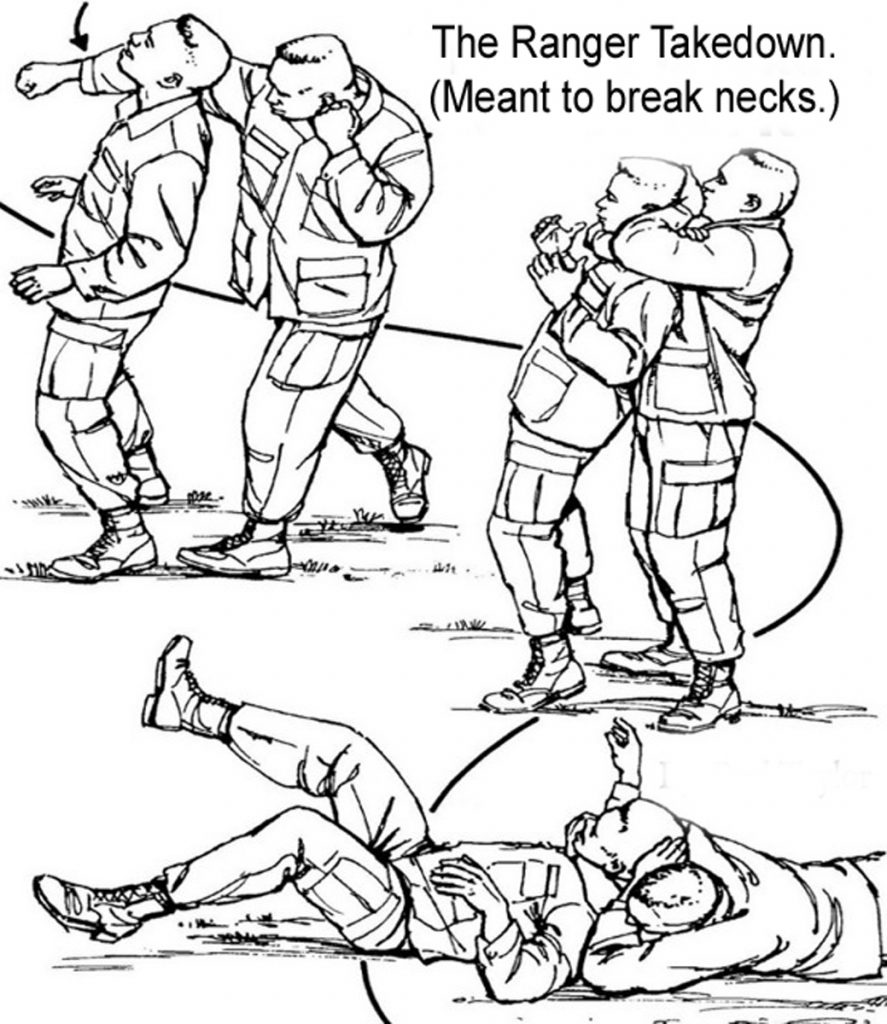
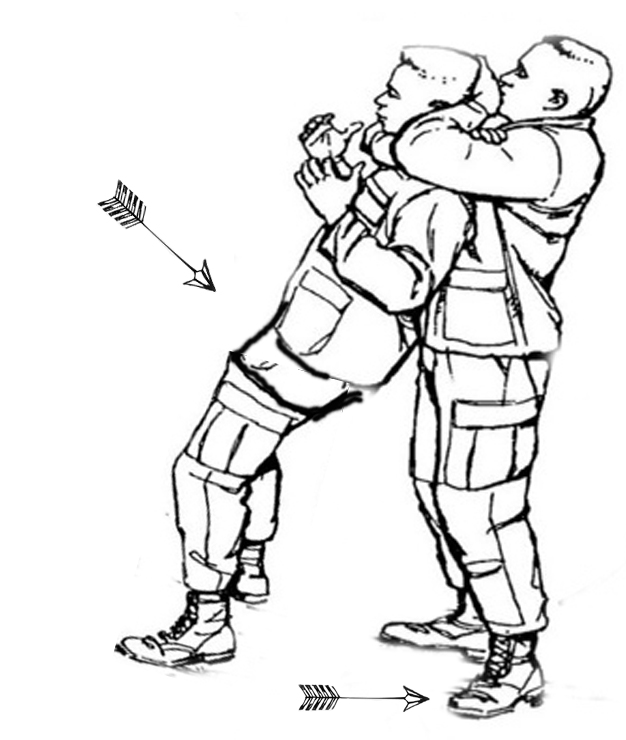
Other related neck structure injuries? I know of a few rather world famous, life-long MMA champs that have stents placed in their trachea due to decades of rough training simulated chokes, and real competition chokes. This operation is called a tracheostomy.
Dr. Earl Morgan, Forensic medicine (and a Judo Black belt) adds…”In all of the combative grappling sports the “choke” hold rules require varying degrees of cervical spine protection. Of course, what makes repetitive chokes in combative grappling so safe (in class) is the health and conditioning of young martial artists. My college judo coach cautioned me to seriously consider allowing chokes in anyone over the age of 40. At the time I was in my 20’s and had no idea what the big deal was. He also spoke of the ‘40-year syndrome.’ This is where you turn 40 and suddenly you have all the aches and pains from all the ways you abused yourself when you were young, whether with drugs, alcohol, athletics, manual labor or other factors, it doesn’t matter. He was a much wiser man than I realized.”
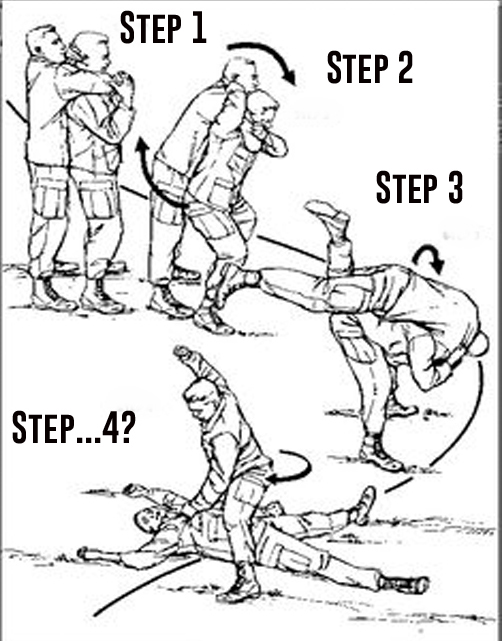
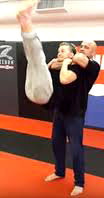
Banning chokes...I have been paid by some police agencies through the years to write subject-matter-expert studies on the validity of neck restraints and chokes. In some jurisdictions worldwide police agencies have continued to defend the use of the carotid restraint hold for decades, claiming that it is safer and more effective than using a police baton, taser, or pepper spray. Other jurisdictions have banned its use entirely while still other jurisdictions have ruled that it may only be used in extreme situations where deadly force is justified.
Most enforcement agencies worldwide have banned this “choke’ tactic (or any neck contact for that matter) for many years now. Some allowances exist for when the officer is faced with deadly force. Yet, in a strange Catch-22 circle jerk, these last-resort, life saving choke options are still NEVER TAUGHT, for fear of…being publically seen-caught just teaching the dreaded chokes!
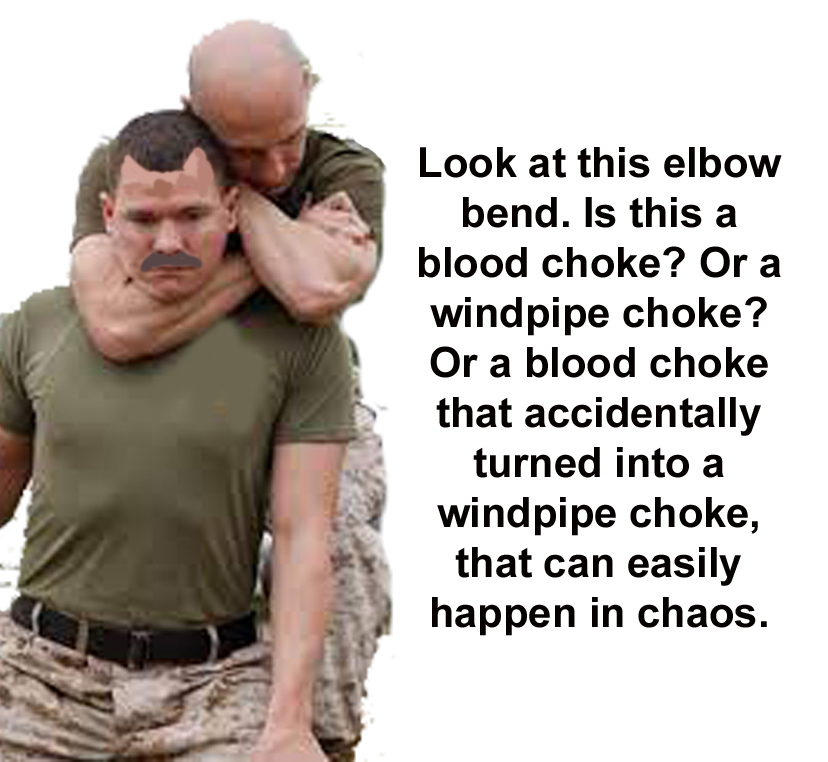
At least think about this...In a military context, other than when trying to capture prisoners, a choke is a strangulation meant to kill the enemy. But for citizens? These same legal-test concerns hold true for citizens. Civilians must be justified under a reasonable dire threat to windpipe choke someone. If you can’t comprehend the facts here, or be able to consider, discuss, teach and articulate them, you and yours might someday be in moral, ethical and legal (jail and lawsuit) dilemmas.
(This essay on non-choke and choke related neck wraps rear takedowns appear in Level 2 of my Force Necessary:Hand course, thus the essay here, which appears in the outline and my upcoming Unarmed Combatives book in 2024.)
______________________________________


Your “table setting” and “know your table” have big meanings, in the self defense shooting world. Ever shoot from a chair, behind a table at the live fire range? Not often I’ll bet. When done, the seated, range training set up, the “table is set” this way – it takes-makes the assumption that you are the “Lone Ranger,” seated alone, shooting an unidentifiable, abstract somebody (the paper target imagined threat) always shooting straight forward from your seat.
I still some see gun courses on film and in photos with people sitting at tables and drawing and shooting while seated, (even reloading there in the chair! And at times doing really awkward 360 checks while seated.) Or shooters fully stand up exposing most of their bodies. Does the table ever get flipped over in this ‘Lone Ranger’ model? Think about all the calibers out there and the fickle deflection angles and how some flipped tables might help.
But this essay is not just about flipping tables. Sometimes you can’t, but rather about all the probable table situations and responses. “Know your table and the table-setting” shooting training via the “Who, what, where, when, how and why” question checklist.
Set the real table with questions and answers. Hopefully in these live fire range classes, these samples of the “Ws and H” Questions checklist was-is mentioned in the opening lecture to introduce and remind the bigger problems of the table-setting shooting?
I do wonder, do the table-chair courses ever finish the live fire range segment with any of the best training experiences? Doing the simulated ammo situations with actors (just other attendees) in common makeshift table settings. (Sim-ammo is all I do.) Real, vital “shoot-don’t-shoot” decision making, interactive experiences.
Yes, you must shoot some live fire from the chair and table a bit. Yes. And then hopefully, in this ‘Lone Ranger’ range set-up, practitioners might practice a segment of oh…flipping tables over and shooting too, and also worrying about where Tonto is, and work on all the other probable things in simulated ammo situations, rather than completely ignore all the training of many other chair-table probabilities.
How do you set the table for table-related gunfights?
_____________________________
Watch full, free training films at Hock’s Combatives TV Channel, click here
A DEEP HIP STYLE ROLLOVER THROW (Or a standing “Fat Man’s Roll?)
This application of an “arm” takedown I have done once in police work in a domestic disturbance. While sorting things out in a house, a man charged me from the rear, having escaped the verbal control of another officer nearby. I heard the officer yell “Stop!” Before he could wrap my torso with two arms (to do what, did he know?) I was able to react.
This reactive move is found a few places but was based for me from high school wrestling from back in the 1960s! (Back then was only some 10 years earlier.) In such wrestling, there are “neutral starting’”positions and “referee positions.” One of the common “referee position’ starting points inside a match was one person was down on their knees, the other atop and somewhat beside him with one arm wrapped around the bottom guy’s torso (rules can differ). No clasping “bear hug” allowed yet at this point. This is not a collegate wrestling course so we will leave it at that.
One of the series of moves we practiced back then was the bottom guy grabbed that wrapped arm and rolled him over. When just freestyle practicing, this also happened when the bottom guy partial stood up at times. I frequently did and saw this work. This complete standing version starts looking a bit like like a classic hip throw, at least in part. Anyway from high school I still had this move, this concept embedded in me.
I remember that the guy rushed me to the point that I might fall over forward anyway. I tried to turn and then this old move from inside me busted out. Stepped back, dropped and rolled. His feet smashed into furniture. We arrested this man and the jailer told me the next day that the man begged for aspirin from a bad headache all night long. I think he hit his head on the floor, possible like in these photos.
I am a proponent of the “double the force” concept – a late phase counter when being taken down. Can you grab the attacker, hang on, join with and add to the force of falling maybe with a turn? Putting him at a disadvantage 1) upon, during impact, or 2) after impact? Sometimes. Yes.
If you are going to practice it, try it a few times about knee high like some Judo (this known as Soto-makikomi) and wrestling does. Watch out for your partner’s head! Don’t forget to hit him at every opportunity, which Judo, BJJ and wrestling does not.
(I only did this one “for real,” one time in my whole life, but I ain’t dead yet.)
_____________

 There are so many examples of this routinely happening. We are probably all familair with misguided use of martial material applications. Look at the May, 2023 case, poor, well-meaning, former Marine case on the New York Subway, choking a crazy guy accidentally to death. Recently again in May, 2023, a woman was attacked by an immigrant in Denmark, an attempted rape. As he tore off her clothes, she sprayed him with pepper spray. Now she is under arrest for illegally carrying pepper spray! The rape suspect escaped. Too many examples to list.
There are so many examples of this routinely happening. We are probably all familair with misguided use of martial material applications. Look at the May, 2023 case, poor, well-meaning, former Marine case on the New York Subway, choking a crazy guy accidentally to death. Recently again in May, 2023, a woman was attacked by an immigrant in Denmark, an attempted rape. As he tore off her clothes, she sprayed him with pepper spray. Now she is under arrest for illegally carrying pepper spray! The rape suspect escaped. Too many examples to list.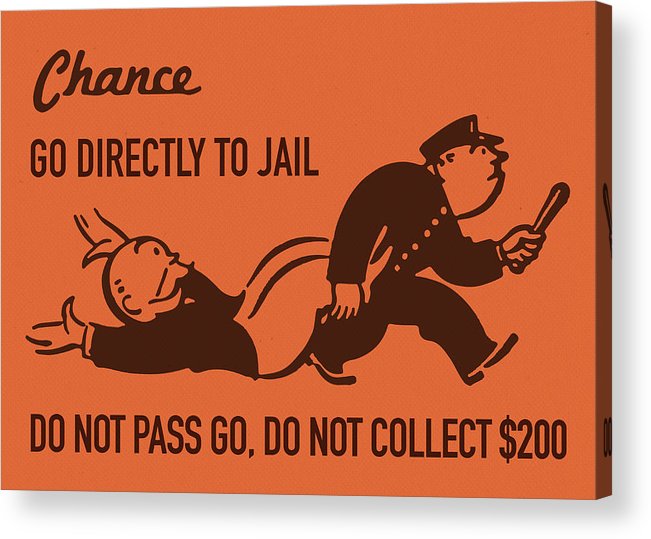 When challenged in court, your system-art will be examined. This does come back to the “What” questions. An instructor-practitioner of any art or system has this responsibility and should answer these “What” questions.
When challenged in court, your system-art will be examined. This does come back to the “What” questions. An instructor-practitioner of any art or system has this responsibility and should answer these “What” questions.
An Orderly or Tactical Retreat, (safely walking or running away!) Stay or retreat? A retreat has several definitions, like “retrograde” movements or a more modern “tactical retreat.” Usually, these definitions suggest that one retreats from a superior force in battle. Military. In today’s civilian world, remaining to fight and take action, may become a physical, legal (criminal law and civil law) nightmare and monetary problem. Winning and the law are often at odds.
Whatever the terms, retro, orderly or tactical, it still means you leave, escape, withdraw, whatever, with the best plan to do so. For a smaller, personal situation an orderly retreat is leaving a confrontation, safely and without being chased, at all, or much.
“Just run away!” these pseudo experts will say. But, just how far can you run? How fast? How long?
The law will ask, if there’s trouble, why did you go there and why are you still there? Can you leave people behind? Will you be leaving family, friends and comrades behind? Can you leave? Should you leave? Sometimes you can’t leave. Your choice is highly situational. Think of any violent situation from a fistfight to a crime, to an active shooter, on to war and ask these questions about staying or leaving?
How exactly will you retreat? If you stay, there will be violence. If you go? Best go in an orderly fashion. When you add the term “orderly,” it speaks of significant specifics. What is this “orderly” version? An orderly retreat?

In his beginning battles he had some large causalities usually from chaotic retreats. When his troops hit their perceived “breaking point,” hey turned and they scattered, most were killed from behind, running in disorderly retreats. Long known, psychological factors reveal that it is easier to “kill from a distance” and to “kill from behind,” without seeing a person’s face, without seeing a “personality.” (This relates to crime also.) Then, Alexander adopted he Macedonian 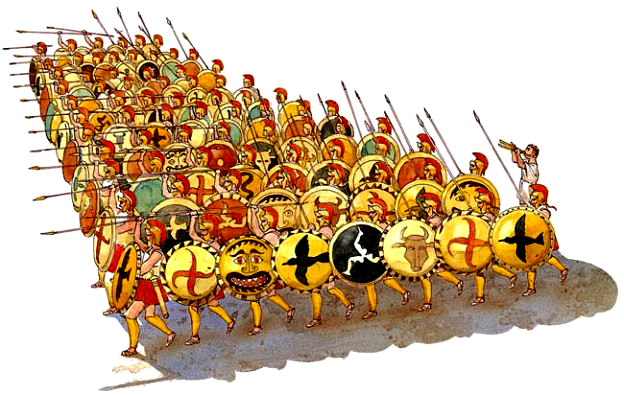
Simply turning and running away, sounds like good advice, but how far and fast can you run, and such may make you easier to be killed, and may ignite an anger, and/or ignite a hunter-chase mentality in a criminal or a enemy soldier. Departing, withdrawing as smartly as possible is better choice.
Turning and leaving. In the martial word, just turning from a too close opponent standing or down on the floor-ground, is “giving up your back” and means something specific to martialists – exposing your back is an invitation to be choked. In crime and war your turned back make you easier to be beaten, captured or be killed. When you turn to leave, it should be done by first backing away in some manner to a safe distance and then turning to leaving.
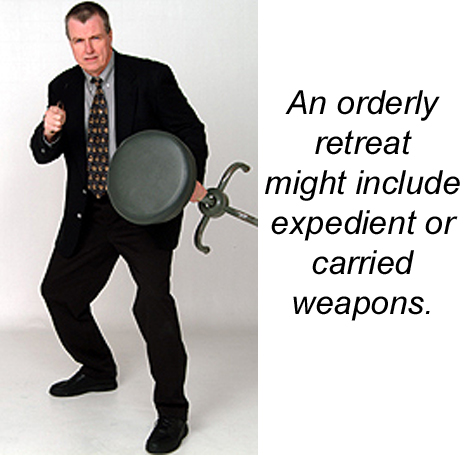
If no physical contact is made yet, we are still in the Stop 1 parameters and leaving the projected fight scene before it starts, is a quintessential Stop 1 situation-problem. But the option to leave may occur in any of the Stops, Stop 2 through Stop 6.

“Hock, sometimes you gotta’ blow the horn,” (the horn being thetrumpet of retreat.) “Always have a go-to hell plan, and another one when that one goes to hell too.”
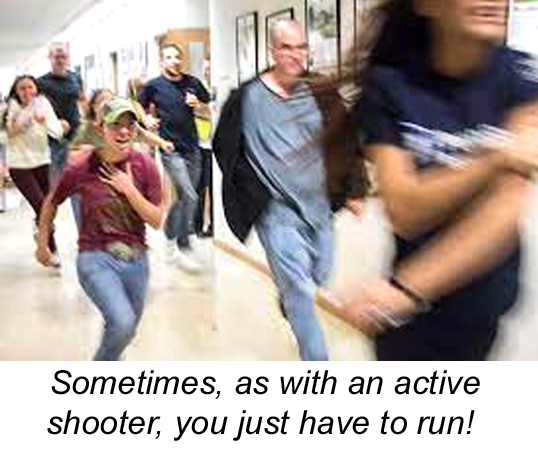
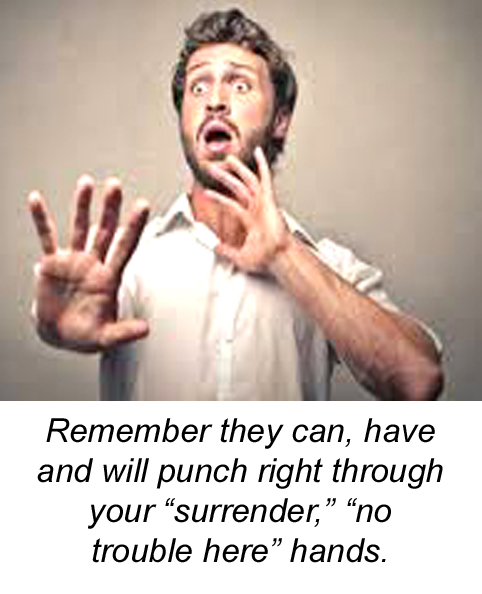
There is no one way to prescribe any one universal orderly retreat, but it is important to understand the concept, teach the idea, and develop and practice some real, “go to hell,” plans.
___________
Watch some free, full training films on Hock’s TV Channel! Click here…
My first Guro Dan Inosanto seminar was in 1986 and he told a story about his high school football team. (I forget the pro players he mentioned). He said that he was a running back and kept crashing into the defense. The coach asked him why did he run the ball that way? Inosanto replied,
Dan did pick and with that advice and he broke many state-wide, California high school running back records. He also added once that his coach made them run up and down steep hills in practice and to run down the hill as fast as possible. Since it was a hill, you ran faster down than on flat ground. Inosanto said it was “a bit like flying.” The coach told them to “remember that feeling of that speed. Mimic it.” (You usually learn a lot of related things at an Inosanto seminar.)
There are dreams of advancing, then there are tools to become advanced. Who knows those tools? I’d never thought much about these things before then. I also, needless to say, wanted to mimic Dan in terms of his knowledge, teaching and overall “cool.”
Improving. I mean, we all knew back then to weight lift to “get stronger,” and to run for endurance. What else? Well, repetition was important. But then who or what were we repeating? Mimicking? What of dedicated inspirations, guidance? Sure there was the Bible and Zig Zigler back then, but I’d never thought about codifying these diverse training ideas, inspirations and tools before 1986. They came very scattered. I was not alone.
I grew up in the New York City area where one could play baseball and football endlessly through countless organized leagues of all ages. I was playing baseball until I was 18 years old, among guys in their 20s and 30s in money-sponsored teams. (I left the area at about 18.) During these times, I and all others were under the influence of numerous coaches, and none had any real savvy about serious, performance coaching, a “teaching I.Q.,”even in high school where baseball, football and wrestling were big. Sure there were tips and some mistake-fixing yes, but not like today.
They’d say, “Playing is learning,” and we hear similar with martial expressions like “Learn to fight by fighting.” But that tops out too at-with your natural level of athleticism. Remember the prematurely athletic teen that was always the superstar high school quarterback? But 99.999% of them end up working in a factory. They topped out in high school. How to advance? Most coaches back then could not perpetuate such advancement. It seemed like much “mimicry” was a main teaching tool back then. “See how ‘so-and-so’ does it. He’s successful.”
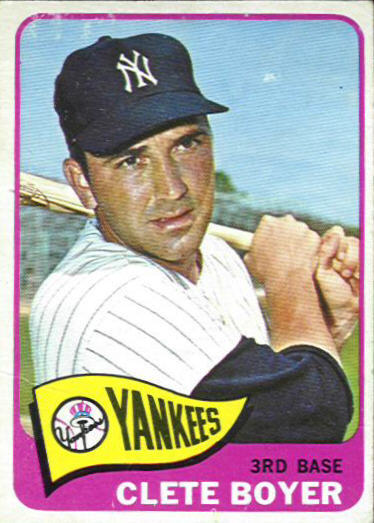

The coaches and Willie identified every single thing in baseball he might face, every little episode, every event. Catching a ball this way or that way. Running from first base to second base, first to third, etc. To my memory they identified some 30-40 specific events, very big and very small. And, during that off-season at this ground-breaking camp, Willie did every one, 100 times each, almost every work day, under their watchful eyes. As a result, he had a rebirth in performance and played several more years successfully. He went back every off-season until other factors, mostly age, interfered. Wow. Another epiphany for me. Tools. Steps. Skill exercises, big and small. Set me to thinking about diverse applications in teaching. Teaching technology, so to speak.
Thank goodness since then, this skill development, this training methodology really caught on, widespread, even down to grassroots, neighborhood league coaching. Officially! (When I coached my kids’ baseball teams I made it a point to take players aside and work on specifics in sessions.) For the last few decades we see this influence in every sport. Records of almost every sort have been broken. The talented continued to improve, The mediocre became better. The lost became at least, found. I also noted such advancements in high school, college and pro football. In the last decades we hear professonal football players talk about the difficult leaps in training from high school, to college to the pros. These methods are all another good form of mimicry too. Mimic the pros’ training methods, not just performance.
Are you way too lanky, tall and skinny to be the baseball catcher? There are reasons most succesful catchers are shaped as they are. We have to remember we are all different. Basic boxing is much the same, but Mike Tyson should not fight like Muhammed Ali, and vice-versa. Dan Inosanto should not run the football like Joe Jones. Don’t over-train in tennis to be a basketball player. Reduce the abstract. Isolate the skill steps and build them. In the Who, What, Were, When, How and Why questions I live for, this is a big “who question.” Who are you? Shape, size, age, strength, etc. Who do you mimic?
Who are your heroes and to what end? Coaches and teachers in these essentially cookie-cutter, sports and martial arts programs must be careful and recognize these differences. Is your “ku-roty” or combatives or self defense teacher a super-star athelete, power-lifter that oh-so does-looks the part? And…you’re not…can you recognize these reaities?
This is why I am obsessed with identifying and teaching the universal, versatile, achievable, core, survival basics foremost. What can most people do? Grasp? Get that stuff done. Work on the probable problems first, then the improbable. Then with good coaching I.Q., recognize natural attributes, steer developments and push people to their private mission success. Its one thing to play a lot of “baseball,” it’s another to excell at third base. At some point, customization must step in.
There are dreams of advancing, then there are tools to become advanced: Two very different things. A major way one advances is with speed, flow and skill drills-exercises. You can’t over do these as many do, else you become a “drill master.” Ask these classic questions:
I am 70 years old now. I have been training and teaching all over the world, meeting with and working out with all kinds of people. Listen to me for a great and important tip. Your “who” changes with time…oh…what…every 5 years or so? Can you still do your once favorite moves? That high kick? That sacrifice fall on the mats, lest of all on cement? Can you still clearly see that front sight on your gun AND-OR your target as well, or are they blurry blobs? Can you still hit that fast ball? Do you need to alter-evolve, dismiss some of your favorite things? Can your 50 year-old self, mimic your 20 year old self? Take stock every 5 years or so of what you do.
There’s a lot to this “mimicry” subject.
______________
Check out Hock’s free Survival Centrix newsletter . Send your email address to Hock@SurvivalCentrix.com
Part One: Definitions
In an era of “words count” and “language precision,” how one defines “Grappling” today is indeed important for system doctrine. Does the noun “grappling” officially and unofficially mean as it once did – “all close-up, hands-on struggling standing and ground?” Or is it now just ground… wrestling? Is all grappling just wrestling now? Is all wrestling just grappling now? Can you punch and be “in” official grappling or not? Does “old school Jujitsu” – full of stand-up moves – still count as grappling? Apparently not…
For many decades, perhaps centuries in some cases, the definitions for “grappling” have remained in place. Grappling was once defined in the books and history as a:
Both standing and grounded. Anything goes, like hand strikes and kicking. Sports, point-scoring and arts were hardly mentioned, and if so in some cases, were not mentioned in the opening generic, dictionary lines but down a bit like in an addendum with samples.
But today! Thanks to the popularity of many modern martial arts, the word grappling has been redefined in many sources only as a “wrestling submission contest on the ground.”
Soooo, grappling is now nothing but a wrestling submission contest on the ground? What does this mean for ground n’ pound (Gn’P)? As a general rule, you can’t punch in wrestling, Judo, or Brazilian Jiu Jitsu, whether it’s in a competition or a training session.” So, that’s it for grappling? Just wrestling?
Sure, scholastic and Olympic wrestling has helped reshape this definition. And we can assume that the latest widespread rise in Brazilian Jujitsu (a BJJ school every three blocks, which is an overall good thing) has also influenced this redefining. In a way, “Brazilian Jujitsu” has hijacked the word “Jujitsu” in popular consciousness. Ask anyone remotely interested in martial arts and under the age of 40 years-old what “Jujitsu” is, not just Brazilian Jujitsu, but just Jujitsu, and they will automatically think of Hispanic wrestling. I don’t since I am way older, and since I did Jujitsu-Jujitsu, and Aiki-Jitsu, well before the marketing miracle of the UFC. (Say “UFC” and I presume people think “MMA.”)
Nowadays, many schools advertise and call themselves just plain old “Jujitsu” when they are actually “full-monty,” Brazilan Jujitsu. The two have become so synonymous. In fact, if you ask Sensei Google any question about Jujitsu on the net, or if even quantifying a Japanese Jujitsu question, Google will usually respond with lines starting, “In Brazilan Jujitsu…” Search on Jujitsu images and I would estimate about 95% of the images are wrestling on mats.
Thats what you might call a martial monopoIy and brilliant advertising added to the fact that pure wrestling is very addictive. And that BJJ domination, along with wrestling and Judo runs deep, and has effected the term and understanding of “grappling” today. But, this redefinition to “ground submission contest,” has shrunk the original meaning. The word has evolved or actually de-evolved, into a fraction of what it once generically was. Bigger picture to smaller picture. One subject in the shrinking is about takedowns. Do you always fall with the person being dropped? Or not?
Sacrifice Falls and Accidental Falls. Wrestling of all kinds start with Stand-Up fighting-grappling, even if Stand-Up isn’t found within most popular definitions anymore. Inside these old and modern submission-wrestling based approaches, they must have ways to get opponents down on the mat to begin their ground, sport submission contest. Some BJJ folks just drop right on their backside now to start fights “at the whistle,” but ordinarily there’s a few stable takedowns and throws. How one takes down is a tribal definer – do you fall down willingly with the opponent or try to stay up? The fall-withs or “sacrifice falls” are easier. The stay-ups to remain standing or knee-high are a tad harder. They’re called by me “Sacrifice Falls” and “Accidental Falls”:
Both “Sacrifice Falls” and “Accidental Falls” can go three ways. For what you do, what fallen, follow-ups would be best for what you do?
Back to the Definitions. I use the older, bigger definition for my Force Necessary: Hand course, the unarmed course. In my doctrine, “grappling” is the “close hand-to-hand struggle standing and on the ground” with no rules, just the laws for crime and war. And “with, without and against mixed weapons,” priority. The study will partially remain in the “MMA-like, kick-boxing-like, stunning set-ups via strikes and kicks, takedowns and throws, and primarily MMA-like, ground n’ pound, (and with choke finishes). (MMA really is the closest sport to reality.) Joint lock-cranks are certainly studied, standing and on the ground for general “martialist’ knowledge, and of course much joint-locking is inside takedowns and throws. All martialists must know how all joints of the body twist and bend, no matter what system they do, this knowledge breaches into ground fighting. They are also used to keep people “still” for awhile, like your drunk uncle…
Still For Awhile? – Submitting Drunk Uncles... In survival combatives, we look at and dissect a few, super basic, simple submissions for those times when our “drunk uncles, other relatives and-or nutty friends” must be contained temporally. Captured, not hurt, because you will see cousin Charley again at next year’s bar mitzvah. But, submissions (other than chokes) for us, are not the over-emphasized-main mission. Not… “king.”

Submissions in Police Work. When you get a bruise on your ass, from the badge in your wallet, in your back pocket, you know you’ve really been real ground-fighting. These experiences, investigating cases have worroied me, helped me “set a bar” a stage, for reality in ground doctrine. What’s works? What’s sports-art. I’ve had to arrest some people. Best records I can amass since 1973 is about 900 people in the field as a patrol officer and detective. Not too many arrests really in all that time. Some resisted, some fought, and a rare few tried to kill me.
Checkers versus Chess. My physical end “checkers move” was to handcuff them. A very large majority of submission-tap-out material were “chess-like, sports-art” and not a priority ending. Handcuffing was. The fight doesn’t end with a tap-out, and you cannot go about your life breaking everyone’s bones to end fights. First off, you should not toss EVERYONE on the ground, all the time. You don’t have to. But standing or ground, if you joint crank-lock someone, and they cry “Ouch! You got me!” when you let them go, they continue fighting or continue to run away. Trust me on this. If down and leg locks? Too far away from handcuffing and not a police priority, In general, I have found old school Jujitsu with a lot of Stand-Up grappling way more valuable.
Chokes were always an intrical part of early police training and “street” use. I have choked out about 10 people or so, maybe 9 or maybe 11? Not exactly sure how many, That’s not many. Standing and downed chokes are a survival priority for all to use (and a prominent place in the Force Necessary: Hand curriculum.)
I scratch my head every time I hear that “all police should be purple belts in BJJ.” Ahhh…no. A world of sacrifice falls? Submissions? Leg locks, Chokes (remember chokes are now taboo)? Wrong world. Maybe an orbiting moon? But not the planet. Just…just no. Reduce the abstract. Police need a customized, unbiased – repeat UNBIASED – course of 100% mixed-weapon, police stuff, dressed in police uniforms. BJJ? Just…just no. Police ground fighting is very different animal and it is a mistake to think pure BJJ or any art should be police-mandatory. Remember the Gracies even started a G.R.A.C.I.E. Law Enforcement course, seperate and much different than BJJ, further proving that pure BJJ is not suited for police. (I hear only mixed reviews and am ignorant about it. I plan on attending someday to investigate. Take note that there are numerous police grappling courses “out there.” Don’t take one given by martial artists. Take one owned, operated by cops or ex-cops who were-are also martial artists.
The military needs it’s own highly customized courses too. Don’t get me started on that fiasco.
Submissions in Civilian world. How does all this blend with civilian self-defense-survival? When civilians wrestle on the ground with unarmed and armed rapists, robbers, muggers, drunks or bullies, I wonder, “What is their perceived end game?” The bad guy says, “Ouch! Okay, I quit!” You then…let go? The once controlled thug will re-continue fighting. Or, will you lay locked on the ground indefinitely until help arrives? If help does or can? Again, the real fight doesn’t end with a tap-out, and you cannot go about your life breaking everyone’s bones as some half-wits might suggest. It’s all very situational and legal-problematic. A very large majority of submission-tap-out material were “chess-like, sports-art” and not a priority ending for normal people, in our real world and circumstances.
So…No More Striking? If grappling means “ground submission contests” and ground submission contest systems deny striking…one-plus-one-equals-two…are strikes and kicks (knees too) no longer allowed in official “grappling?” For me, no. I stick with the older definitions and “ground n’ pound.” Speaking of Gn’P, remember the old Gracie quote?
GnP is a mandatory priority for ground survival. Roger Gracie once said that, “80% of BJJ is usless in MMA.” Rickson Gracie said it was 75% useless. Many people think I am useless and dumb, but in all my years of doing, watching, investigating, experimenting, classes, seminars, working out, arresting people, I agree with these icons’ opinion. I am not alone.
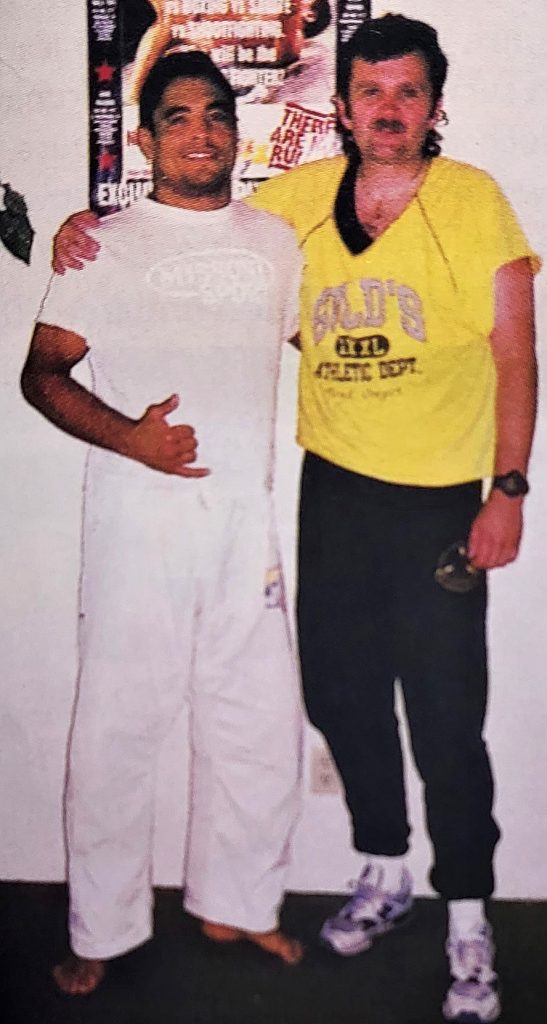
Looking at the UFC, ESPN reports the headline: “How MMA Fights End: Submission Victories Way Down” “Less time is spent on the ground overall,” they report. Gn’P way up. Chokes are catagorized in the submission category numbers, so how many of the vanishing submissions were chokes? Take away the many choke stats and what’s left in the shrinking submission sucess category?
There are of course splinter groups with some strikes, “grappling” with wrestling-only problems and trying to introduce realities. Like Eddie Bravo’s Combat Jujitsu that allows for hand strike slaps. “Strikes can only be done with an open palm. Palm strikes to the body, the face and the side of the head are considered legal. No closed fists allowed. Standing grappling is only permitted for 1 minute maximum. After 1 minute of standing, a horn sounds and the referee enforces the “Get Down” rule. There is then a coin flip and the winner decides whether to be on top in their opponents butterfly guard with double under hooks or on bottom in the same position reversed. If the one standing has clearly been the aggressor then they automatically win the coin flip.”
Okay! That’s kind of complicated, but as I said, there are splinter groups. Even the Gracies had to start “Gracie Combatives.” Why? If it was so perfect in the beginning as advertised, Why? Just…just stick with today’s generic MMA, I think. It’s the closest you’re gonna get. It is interesting that when wrestling systems add so-called “self-defense,” offer self defense versions, they start losing their origin dogma-doctrine, their original “look,” and become… well… combatives. (Ahhh – that’s my planet.)
Speaking of the UFCs of the world, I must quickly mention that I have a process in my evaluation of a hand-to-hand tactics-techniques. I have two questions in that vein…
In summary, fighting system doctrine, not dogma, guides the system. Mission. Martial I.Q. studies the ways and mean to develop doctrine. Definitions really count. They they might change “right under our feet” (yes a pun). People do what they do for a variety of reasons. Know your reasons, the definitions and the doctrine. Be happy. Be educated and content on your planet. Know why you’re there. Or? Hop a spaceship.
Part 2: Smart Ass, Dismissive, Gaslight Remarks
BREAK! OKAY! STOP! You Can Stop Here If You Wish! Now This Essay Has a Two-Fold Mission. One mission with this essay is to examine the meaning of grappling and how it’s changed to suit marketing and the times. And the other subversive mission is using the public definitions for – well – a long, long awaited response to the occasional ignorant criticism of me and what I chose to do, my courses. My mission. I usually ignore these biased critics, but when some reach arrogant, ignorant asshole levels it just becomes harder to ignore.
Though I have worked “hand-in-hand” with Catch (my favorite) and BJJ people, I do still seem to aggravate a small percentage of doofuses. I sometimes hear the smart ass, dismissive remarks that…“Hock knows nothing about grappling.” Another classic retort is the advice that since I am so utterly dumb and blind that I just need to join a BJJ school to finally understand what real “GeeeRAPPLING ” is. (As if I have never had explored all this.) These critics rely on their smaller, definition of the word “grappling,” the “submission ground contest” version, and they have no idea about me, my past and my mission. They read a short something I written or said… and… assume I am dumb. You see, for them, I haven’t joined their tribal church, seen “their light” as they know it. But, I am not quite as dumb as you think.
The occasional half-wit, hyper-sensitive assholes even type this, “You wouldn’t last 5 minutes in the UFC MMA ring.” Dear Idiot-boy, I am 70 fucking years old, I wouldn’t last one minute with 30 year-old, 6-day a week, fight-athletes in the ring. But here’s another secret your peanut brain hasn’t figured out. About 95% or more of martial arts instructors and students in the whole planet wouldn’t last 5 minutes in the UFC – MMA ring, young or old.
I am rather familiar with their matted landscape. In police academies and waaay back when in, in-service training there was much control and contain ground fighting, with strikes, kicks and chokes. Once very brutal, the police doctrine got paranoid by around the 90s and the more rough-stuff disappeared. As I said, chokes are pretty much gone. The old police stuff was Catch, Judo, Jujitsu, even old-school Karate. I enjoyed the regular Police Judo classes the military police offered, which were all of the aforementioned, but much situational police-problem-solving also. (They called it all police JUDO back then because “Judo” was a popular word.) In the 80s I started with Jujitsu, Aiki-Jitsu and JKD which was always “up and down.” In 1986 I started up with a deep dive into the Inosanto Family which was already hooked up with Gracies and Small Circle Jujitsu. I was a Larry Hartsell fan and regular attendee of his chock-full-of-Catch-Wrestling and other “grappling” moves. I got to a Level 5 in the Inosanto Family system which included Nakamura “Shooto” shootfighting-shoot-wrestling. Fantastic stuff. High grade MMA. Also luckily for us, there was a famous clan of BJJ guys in the DFW area that put on seminars and open mats in the 1990s. Great people and great stuff. Meanwhile, I studied Aiki-Jitsu (A.J.) to Black increasing my time at throws and takedowns. (Once an A.J. uke was grounded though, A.J. hits or stomps him, as with Parker Kenpo which I started out with in 1973. Little ground time-stuff there, and all stand-up grappling and throws-takedowns… which I guess, doesn’t count anymore? In the newer, “contest-ground-submision” grappling definition?)
The Resisting Opponent…Thing. The nice advice also comes in. “If you just would wrestle for “a year” against resisting opponents, you would build your “Spidey Sense.” This “resisting opponent” is a sales pitch thrown out to others and to me and my presumed dumb self. (My accumulated experience in this subject is already well beyond “the theoretic year.”) My “resisting opponent” in “combatives” is also trying to punch, elbow, face maul and possibly kick me too. Their resisting opponent will not, does not, won’t punch, maul, elbow, kick or cheat. In the end whose “spidey sense” will be smarter for survival? Whose muscle memory will be “better?”
Muscle Memory- The Lost Strike – Forgetting Ground and Pound. Through all the wrestling-related materials I worked on, I worried about “muscle memory.” That if I just did that too much, I might forget striking, blocking and kicking. I had numerous friends in Judo and later BJJ, who, essentially, literally, forgot to punch, to hand strike. I’ve seen this type of loss many times over the years. Striking is not in the doctrine-dogma. I worried about me missing survival opportunities and would from, well, brainwashing forget striking and opt instead to roll and roll around.
I recall one time when a batch of “new kids on the block” were doing a seminar involving unarmed fights inside cars. These guys are biased BJJ-ers. Car fighting is logistically hard to teach-show because car interior wrestling destroys the insides of cars or they have to “hold back” from reality to save the cars. After a few sessions, I commented that there was not a punch, elbow, or palm strike, head bouncing off window-dashboard or door post in the whole somewhat, cooperative car wrestling match. None were taught either in isolated, outside-the-car possibilities. One of the hyper-sensitive instructors responded, “You know nothing about grappling!”
Oh? Huh? In 26 years in police work I’ve had to climb into and remove and fight people inside cars. Palm strikes, hammer fists and elbows were VITAL. That gaslighting angry instructor? He sells insurance and has a commercial BJJ school. So as not to embarrass him, I said little in reply. I so wanted to say though – “And YOU know nothing about fighting inside cars, bubba.” Shoulda. But I didn’t. As I am not that type of public asshole. (And you know otherwise, that guy is great BJJ-er and a very nice guy, but I guess, just hyper-sensitive.) But, there was that classic line again. Make a comment about the limited, inherent inefficiencies of wrestling muscle-memory? Bingo! You get the standard gaslighting remark. It’s like a rehearsed line from a passed around script. That line the best you got?
Simulated strikes on friends in training aren’t felt or recognized at all, and these things become worthless in “pressure testing” and “resistance experience.” You always end up in wrestling matches because ignored simulated strikes don’t count and slowly, innocently, disappear, de-evolve away. The ignorant, shallow person with a low martial I.Q. can’t recognize this training problem-conundrum. In MMA matches, this is not a problem. They strike “when the iron is hot” for real. When the hole is open, and the hole opens a lot. In combatives this concept is not a problem either. If there’s a hole? They hit it. We must recognize and reward these in simulations to ensure proper doctrine. Real reality training can at best, sometimes, involve acting. Say that last line aloud twice.
One flippant daushbag said once that he bet I’ve never had someone really grab me around the neck. Well, Ding-Dong, I have. The guy damn near broke my neck and killed me in South Korea. I broke his finger to survive. I have been put in the hospital and I have put people in the hospital. But ding-dongs don’t know me.
Seemless Fightng, Not Segmented. In my hand, stick, knife and gun courses, I have a motto, “everything you do standing, you should try and do on the ground.” Constant experimenting. We are constantly, consistently doing combatives on the ground. Striking, kicking, trapping-pinning, choking, drawing weapons, shooting, slashing, stabbing, even taking this or that joint lock-crank…on the ground. I am committed to the seamless application of all good moves, from standing through the ground.
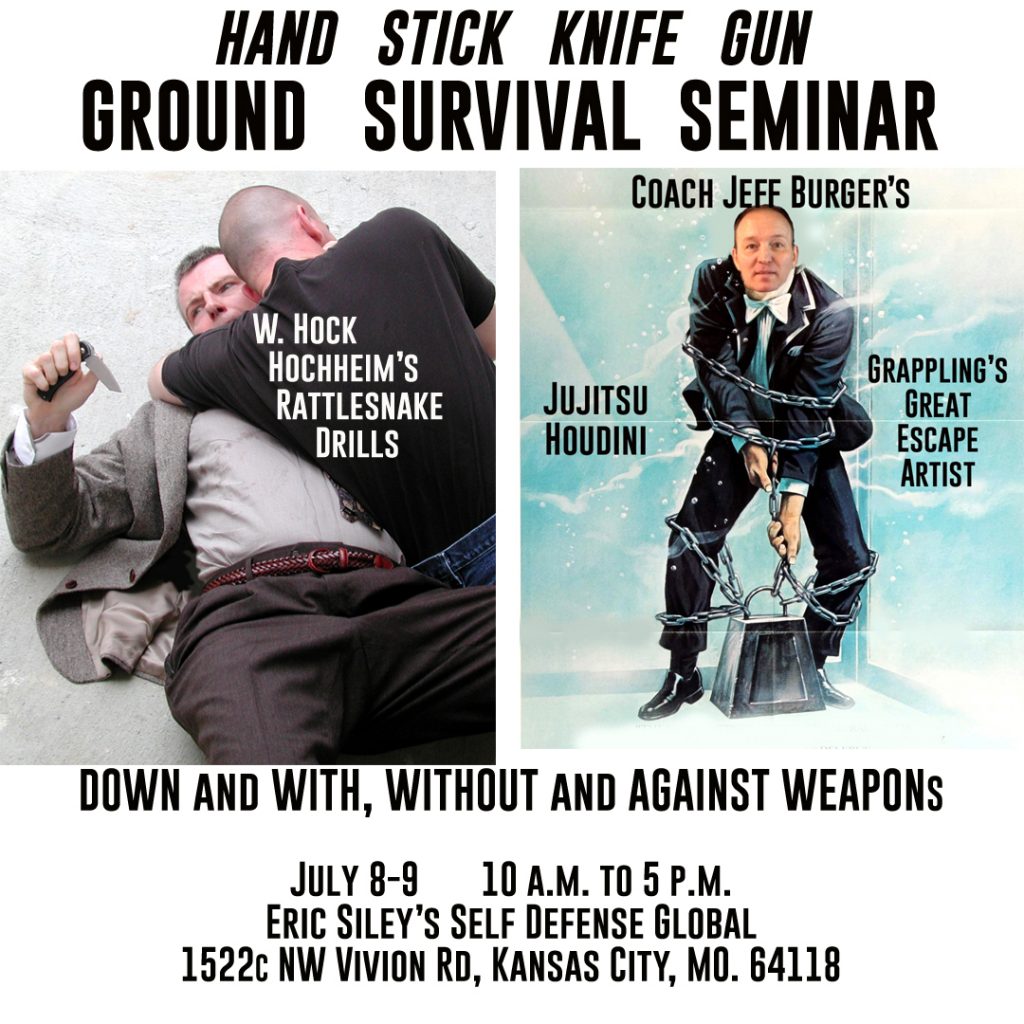
In my hand, stick, knife and gun courses, I have a motto, “everything you do standing, you should try and do on the ground.” Constant experimenting. We are constantly, consistently doing combatives on the ground. Striking, kicking, trapping-pinning, choking, drawing weapons, shooting, slashing, stabbing, even taking this or that joint lock-crank…on the ground. I am committed to the seamless application of all good moves, from standing through the ground. What do you think I’ve been exploring-doing for the last 51 years? I do know something. I am not as dumb as you think.
But gaslighters? It’s just I don’t look like you, dress like you, think like you, act like you, seek what you seek, we don’t start like you, or finish like you and our middle is different. I… have… a… different… mission. Just because I don’t worship at your church, doesn’t mean I’m a heathen.
Summary. So in a world where “words count,” precision language is important. If your only definition of a grappling expert is just being a dedicated master of tap-out, submission ground contests? Then maybe you are right about me. I do not know the tons and minutiate about your fractional, smaller definition of “ground sports contest grappling.” Maybe in that regard, you should get all uppity-superior on me. Go ahead, but try not to be too much of an asshole? I might just agree with you. I am always looking for tidpits I can alter, process, use and teach. And counters. Counters to everything. When I am there to learn, I am not there to replicate systems, I am there only to learn how to beat systems.
Oh, and to the asshole, hyper-sensitive commenters with ignorant, snap, gaslight judgements, with no internal filters bordering Tourette Syndrome…who really don’t know shit about me. Fuck you. Fuck you and the horse you road in on – remember in the very big picture of hand, stick, knife, gun crime and war? Your horse is really defined as a very small, one-trick pony.
______________________________________
Usually, one breaks their hand when punching the “Bicycle Helmet,” top area of the head. The opponent ducks or ducks-and-turns his head and you, whether thrusting or hooking, when your bare fist hits the “helmet” area, your hand gets jacked up. But here is an odd story of my busted-up finger not near the helmet. (Here, Tom McGrath of the UK is helping me demo this underarm delivery uppercut in Belgium, the centerpiece move of the essay.)
One night I was arresting someone, and he decided to fight me. And in the tussle he threw a pretty lame thrusting punch or push, or perhaps a bad blend of both at me. Anyway, I wound up in this underarm uppercut position – which is a popular training position – and I punched him in the chin. Pretty decent shot as he was bewildered enough for me to yank that arm around his back and handcuff him.
BUT…I remember the sharp pain in my middle finger. While booking him into the jail, it swelled up and of course I knew the lump wasn’t cancer. I knew it was from the guy’s damn, pointy jaw and the solid position his head was in. Well, the swelling went down in a day or two. Pain went away. Another come-and-go.
Through the years though, cysts appeared and disappeared in that space in the space between the middle finger and pointy finger and up the middle finger. Small-sized and medium-sized. I thought it weird, but they eventually came and went away too. Then one month, one lump got so big that I really couldn’t do much with those fingers. When I couldn’t put stamps on envelopes, I decided to see a hand doctor.
Diagnosis? That punch from many years back put a hairline fracture in my finger bone from the knuckle to first joint. The fracture edges were rough with growing bone spurs and the spurs caused cysts. Cure? Hand Operation! Remove the growing octopus of a cyst and shave the bone. Nothing to fix with the hairline fracture which I gather was naturally, “glued” somewhat together from time. (Yes, the cyst in a jar he showed me looked like a min-octopus.)
We hear a lot about broken hands-fingers from fights, and I have had a few classic hand swellings from punching people on the job, but when punching I never had common breaking problems many other cops (or people) had, which was kind “blind-concept punching,” I guess you could call it. From training I just aimed lower and held a tighter fist (tips from old ku-roty). I just had this lasting one problem, one I think rather uncommon for me, from an uppercut, down below the “helmet.”
I don’t want to start a long scientific punch vs. palm strike dissertation here, nor create the martial hand damage medical list. I am not against bare-knuckle punching. Other than the “helmet area,” heads usually do “give” when struck, jaws give, necks allows for movement, but there’s much less give in that bicycle helmet area. People see…INCOMING! and reflexively drop their face. Where the nose once was is now the “helmet head!
Fists must be tight, not loose as bad habits create inside boxing gloves. (Bad habit, ask Tyson.) When we fight for real, we won’t be wearing gloves and a mouthpiece and bare knuckle fighting is a real-deal, end challenge. Prep for it yes, but I don’t think we should destroy our knuckles and hands hitting hard things that don’t give-way somewhat, as done for decades like with old school karate-kung fu people. (I know old-timers that cannot hold a cup of coffee in their hands today from makiwara boards and the like. There were times when monster knuckles were badges of honor.)
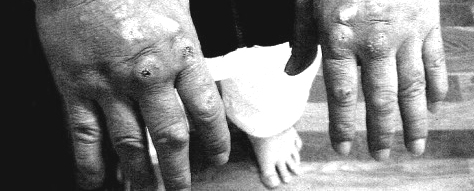
Tone that down! You don’t want to meet the “Situs Brothers – Arthur and Burr” in your 50s and 60s. Rather we have to “strike” a compromise, pun intended.
I also think instructors should take a look at their practitioner’s hands and inspect the size, shape and potential for real-world punching. Some people ae structured to punch tanks, others have little thimbles for fists and should not trust punching anything, despite the endless focus mitt and bag drills they are forced to do. In the end, your job is to build customized, personal success as a doctrine, not replicate cookie-cutter dogma results. One size does not fit all. One system does not fit all. One sized fist training does not fit all.
Anyway, all’s well with that finger now. Hey, remember the bicycle helmet area advice! Aim lower. Tight fist.
________________
Watch free, full training films at Hock’s Combatives TV channel. Click here.
I have been lucky I guess, having done CPR on a few folks though the years and they all lived. EMTs are doing it all the time. with mixed results. But citizens? Adam Gent of Real First Aid in the UK wrote this important consideration.
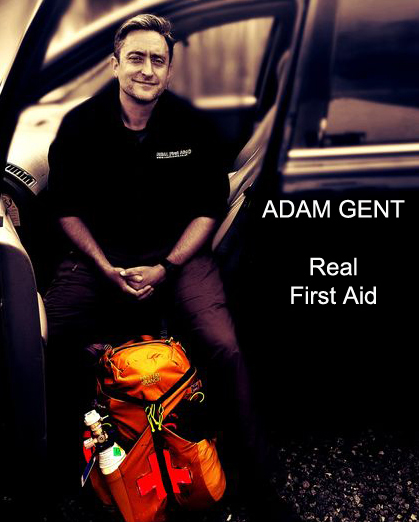
Dark humor.
Ill-founded optimism.
Don’t get me wrong, I am a big fan of dark humor. But if we create an environment where only dark humor is allowed, we do not allow any space for difficult conversations – every opportunity for a meaningful conversation is deftly deflected with an automatic joke and crippling bravado.
What do I mean by ill-founded optimism? Telling people “CPR saves lives” as though it is a given. Because it doesn’t. The absolute vast majority of people who go into cardiac arrest stay there. Forever. But I get it. We want to foster optimism; we want candidates to go out there and do their best. Why wouldn’t you try? But to tell people that CPR can restart a heart or that it can ‘bring someone back from the dead’ is just cruel.
I have lost count of the number of people I have met who have told me about their experience of having to do CPR, and it predictably follows the same format “…so I did CPR…but they died.” With a look of absolute desperation, blame and guilt. All because they were told that CPR saves lives, but in their case it didn’t. How unfair is that?
I know people who have performed CPR on their family or friends who are clearly dead, because the Call Handler told them to. Their last memory of their loved one is brutalizing their body and the taste of their vomit in their mouth. Because they didn’t have the confidence to accept they were dead and nothing could change it, because they were told “Only a doctor can declare someone dead” or that “once you start CPR you can’t stop” or some other nonsense.
Make time for difficult conversations about how woefully unsuccessful CPR is without a defib or within a reasonable time frame. About accepting that dead people tend to stay dead. They were dead when you found them, they were dead while you were doing CPR and they stayed dead afterwards. Nothing changed. It was not your fault. Make time to talk about loss and grief.
Difficult conversations are worth having precisely because they are difficult.” – Adam Gent of https://www.realfirstaid.co.uk/
With advancing age and advanced age, one’s reliance on “kuraty” wanes. Someday I know I will be limping around with only my snub-nose, hammerless revolver in my jacket pocket as my only and last resort, despite all the years of training. And what of those who’ve never done any “kuraty?” These inevitabilities make one think about handy support, self defense weapons. Like the small handgun and one might be…the mysterious, intriguing…blackjack.
Andre Wong of Police One defines: “The sap, slapper, or blackjack is a heavy leather pouch, eight to twelve inches long, filled with lead and sometimes a flexible steel rod. Unlike a baton, a sap’s size and shape allowed it to be concealed inside an officer’s pocket. Saps may not look as intimidating as a gun or a baton, but thinking they’re not dangerous would be a mi stake. A sap is dense enough to break bones when the user has room to swing, and the leather edge is rough enough to cause a dull, ripping laceration to the face when used as a jabbing instrument. Slappers would be ideal for use in ultra-tight quarters like a fight on the ground against a large suspect.”
I noticed a number of folks selling and teaching these tools of late. And numerous training videos. I see a lot of artistic, photo displays of weapons on Instagram, and most include saps laid amongst knives and pistols, etc. Given the laws of most states in the USA and countries around the world, I am not too sure you want to be “caught” carrying one, or using one. I am not too sure many of these teachers, photographers or makers have ever used a blackjack in a fight? Not that, that is a mandatory rule. Smart people can invent and teach smart things. Or, have they considered the vast legal ramifications of wearing and using a blackjack?
The law? Here’s just one example, from the People’s Republic of California and the many states that swap legal weapons lingo: California Penal Code 22210 PC makes it a crime to manufacture, import, sell, give, or possess leaded canes or batons (or other weapons in this category). The offense can be charged as a misdemeanor or felony. A conviction is punishable by up to 3 years in jail or prison. A leaded cane is a: crutch, staff, stick, or rod (later defined as any blackjack) that is weighted with lead so it can be used as a weapon. The statute also applies to short and weighted objects that can strike a person.”
Okay! Then, well, so much for California. You heard it’s illegal, but it sort of “brings it on home,” when you read the actual laws. I fail to see the word illegally “teaching” in there, though. Exponents, fans and sellers say that in most states you can own one (at home), but warn not to carry one or use one. ETSY sells them as “novelty paperweights.” Others advertise them as “change purses with stout handles,” with coinage inserted via a zipper on the striking end for weight. This fools no one.
Police carry. I was officially issued and carried one in Texas policing for many years in the 1970s and mid-1980s, though I rarely hit anyone with it as I was trained and training in empty hand systems so much, I used that first and foremost whenever I could. I noticed that others less trained, whacked the crap out of people with them. I have seen people stunned and knocked out by them, and upraised fists smacked by them – instant, significant reaction. In the U.S. Army Military Police and in Texas we were also issued batons, which again, I didn’t actually use much, though rules were pretty “stick-free-wheeling” in the MPs. (We were even taught to quick-search a body with a stick, rubbing it all around the potential weapon-carry spots, which now…would probably be considered rape of some sort.)
Where did we tote that thing? Believe it or not, in the golden, olden days, usually in our back uniform pocket! Able to be easily yanked out by any miscreant! In my small world I’ve never seen that happen, although stats tell us that lots of resisting people did and do like to grab our stuff and it has probably happened. I have had some attempted gun grabs (one on the ground) and handcuff grabs. Some uniforms had sewed-in sap pockets on the thighs. I hear that some uniform companies still add these “sap pants pockets” (costs more) as a matter of routine…but remain empty.
Empty? Many police agencies, mine included, decided one day in the 1980s to collect up all the blackjacks and hide them away in dusty closets. Night sticks also slowly de-evolved into expandable batons, then for many agencies all “sticks” also completely disappeared (along with those BIG flashlights).
Blackjack Training Issues and Problems. I sometimes consider slipping a “Blackjack Module” into my Force Necessary: Stick course, because it is an impact weapon. I often consider too, changing the name of Force Necessary Stick, to Force Necessary: Impact Weapons. But, it doesn’t “sing” so well as the core, four single nouns, “hand, stick, knife, gun.” Imagine that added, elongated song title of nouns –
“Hand, Stick-Flashlight-Blackjack-Sap-DanBong, Knife, Gun.” That makes for a long album cover name. Even adding the term “impact weapons” replacing the solo word “stick” rambles on, “Hand, ‘Impact Weapons’ (instead of just ‘Stick’), Knife, Gun” is still too long for me. It is hard to replace the simple, message “impact” (yes, pun intended) of single-syllable caveman, “Hand. Stick. Knife. Gun.”
With blackjacks I have other reservations other than just too many syllables and nouns in the title. Mostly those weapon laws, yes, and then “supply and demand” problems. First off, they are illegal to run around with almost everywhere to begin with, lest of all a box of them. But then so are samurai swords and that hasn’t stopped classes on them! Just don’t walk into a Walmart wearing a katana. People like to study all kinds of stuff from esoteric to practical.
If I taught the sap subject, I would need to travel worldwide with a supply of, a bunch of actual saps or training saps at seminars for attendees. 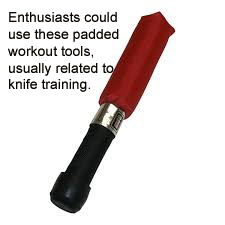
In my world I’d need like…25 or 30 of them. And do you now much stuff I already fly with? Boxes of stuff. Why so many? There’s not much worse than having a specific, weapon-topic seminar, or a session within a seminar, showing up and no one or almost no one has that specific training weapon. I could tell you stories. You are talking to a guy who’s been stopped in Australian airports because I had a box of wooden pistols. What safety, look-a-like, substitute could I fly and drive around with such a box of stuff, that would be blackjack-like and yet, not get me tossed in TSA or the local hoosegow for illegal weapons? Just one real one in my luggage or to and fro the seminar could be legal trouble.
Making the blackjack subject matter a mandatory part of the FN:Stick course, makes these support accommodations on me mandatory too.
The padded knife-dueling tool shown here is an option but it is not perfectly shaped, removing the nuances of the weapon. (This is also a knife problem when trying to emphasize the knife’s edge with a rounded replica.) And…no strap! You have to experience the scenarios with the straps-lanyards.


Fad or Fad Not? In the big picture, I suspect that the subject matter is a fad. I am not a passing-fad-boy. And, I don’t mindlessly replicate fads or fad makers. Fun, but a fad and at this point, I can’t see it as much of a big, crowd-drawer or a big, crowd-pleaser in the big picture of the so-called “civilized world” – in that the damn thing is illegal most everywhere. Of course, I could be wrong and blackjacks and saps might sweep the globe. And in a “free state,” if asked I guess I would cover the topic.
Despite the legal hassles, still the lore and the look of these little scrappy, tough bastards are intriguing enough to stay alive for “free staters,” collectors, gawkers, historians and self-defenders.
__
Hock’s email is Hock@HocksCQC.com
Subscribe free to Hocks Combatives TV, youtube channel and watch free, full-feature training films, 11 free films a year, about one-a-month as our elves like to take Decembers off for the holidays. Click here.